#Marble patterned crafts
Explore tagged Tumblr posts
Text
#Marble Paper#marble wrapping paper#suminagashi ink#marble paper price#marmorpaperie#green marble paper#red marble paper#black marble paper#marble cardstock#suminagashi paper#hand marbled paper#marble tissue paper#blue marble paper#yellow marble paper#white marble paper#Marble patterned crafts#Global marble paper trends#Traditional paper marbling#Eco-friendly handmade paper#Creative paper projects#Artistic stationery supplies#DIY marble print ideas#Handmade paper decor#Specialty paper products#Marbled paper artistry#Sustainable paper crafting#Handmade paper innovations#handmade Marble print paper manufacturer
0 notes
Text

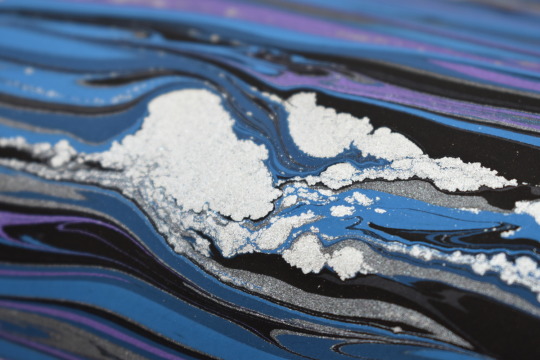


"Gotham Skies" is another one from the new "Skyscapes" marbled paper collection. Release date is April 6th - next Saturday! Sales starts at 12 UTC.
#handmade#pattern#marbling#surface design#marbled paper#renato crepaldi#bookbinding#decorativepaper#bookmaking#interior design#surfacedesign#colors#paint#papercraft#paper craft#paper art
66 notes
·
View notes
Text

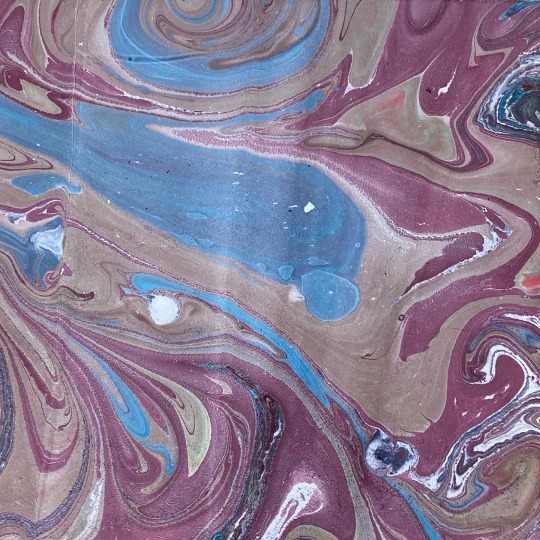

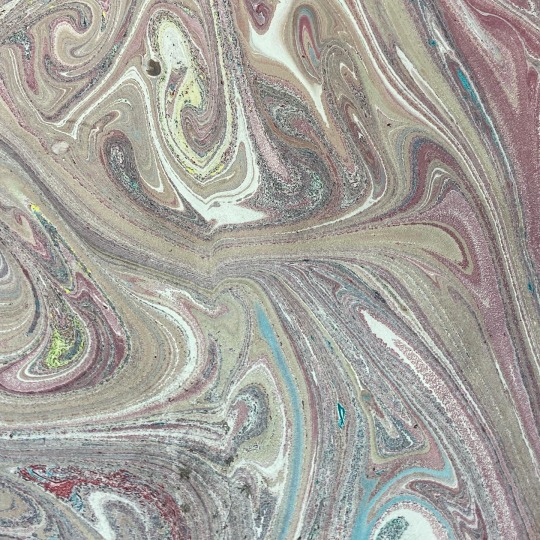
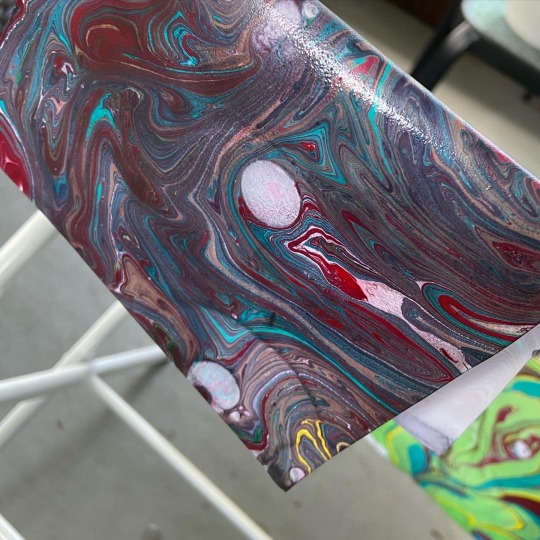
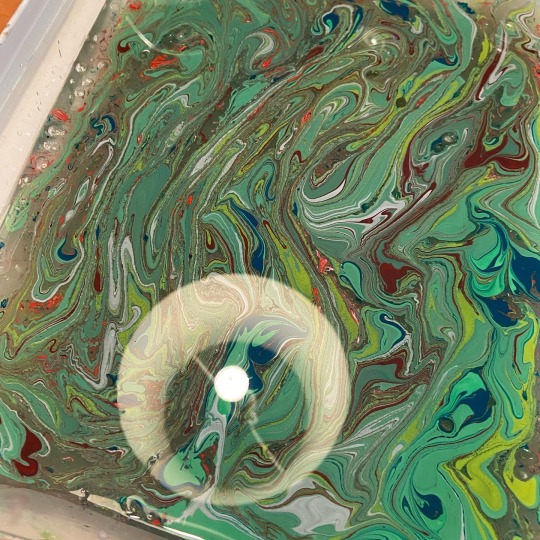
Absolutely obsessed with Victorian endpapers and had to try marbling some of my own
#paper marbling#marbling#marbled endpapers#we are trying more complicated patterns next time boys#my art#my crafts
8 notes
·
View notes
Text
Coffee colors bouquet pattern marbled scarf
#youtube#wow#art#dye#dyeing#silk#silk scarf#textiles#fabric#marbling#paint#satisfying#videos#video#skill#marbled#amazing#how things are made#how it's made#marbled pattern#marbled scarf#talent#clothing#cloth#fabric crafts#fabric art
0 notes
Text
loving jason todd is like caring for an old marble statue.
he looks like something straight out of greek mythology, something pygmalion would have crafted with rough hands and bright eyes for nights on end. scars from battle like ares, or maybe he's closer to hephaestus considering his past.
but time hasn't treated him well, he's been broken and put back together more times than he can count. there are bad days where he can barely feel the parts of him that had once been taken away only to be stitched back on, where he feels like he's missing arms or ribs or even his head, and he feels as if he'd be right at home between nike of samothrace and venus of milo.
those days, he forces himself through the dark, grimy streets, body on autopilot as he watches limbs that aren't his own fight and bruise and bleed.
but then he comes home to you and slowly, slowly he feels whole again.
your fingers gently tap his before tugging at them, digits intertwined as you raise his hand up to your lips. you're just so warm and suddenly he feels his hand again, that fuzzy feeling gently running up his arm like spring water. he's thinking that the way your fingers are laced together reminds him of the crochet pattern he'd been trying to learn last night when before he realizes it, his other hand is moving on its own, finding purchase on your cheek.
it can't be a pleasant feeling, he thinks. he knows for a fact his hands are rough and calloused, years of abuse caked onto them in the form of scratchy white spots and ugly scars. but before he can take it away, you lean into it, nuzzling his palm as if it brings you comfort.
he brings you comfort, he realizes.
he stands there for a while, both hands now cupping your face, careful not to hold on too tight. his thumbs brush over the apples of your cheeks, feather light on each eyelid, one even traces the slope of your nose. you're so soft, flesh easily giving way under his touch and he can't help but feel like an elephant who's been given a kitten to hold.
then finally, he arrives at your lips.
he traces your bottom lip first, one slow, gentle swipe, before giving some love to the top. without much thought, he places both his thumbs over your lips like he's seen people do for stage directions, feeling the little squish when he puts just the slightest bit of pressure. your eyes open narrowly and he finally cracks a smile at the sight of you all smushed.
you open your eyes wider and his smile softens, his gaze locking onto yours. he feels like he could drown in them, drown in you, and he'd die happy this time.
he doesn't realize either of you are moving until his eyes physically can't look at yours anymore due to the sheer distance and the angle, instead slipping closed as his lips meld onto yours. he can feel the warmth in his cheeks and each kiss feels like pure bliss, the contact grounds him so that he feels like his head's on straight again. he's sure you can hear his heartbeat - after all, it's practically thundering against his eardrums - and the rhythm it knocks into his ribcage feels so real that the bones there can't possibly be missing.
jason feels every part of his body. in a good way. everything the world had ripped away from him now returned and fixed back in place by your warm, loving hands. yes, he may be a little weathered. yes, he may never feel brand new again. but really, does any of that matter when you look at him as if he's a masterpiece?
#jason todd x reader#jason todd drabble#jason todd#jason todd x you#jason todd x y/n#red hood#red hood x reader#red hood x you#red hood drabble#red hood x y/n#jason todd comfort#jason todd fluff
1K notes
·
View notes
Text
Fantasy Guide to Interiors



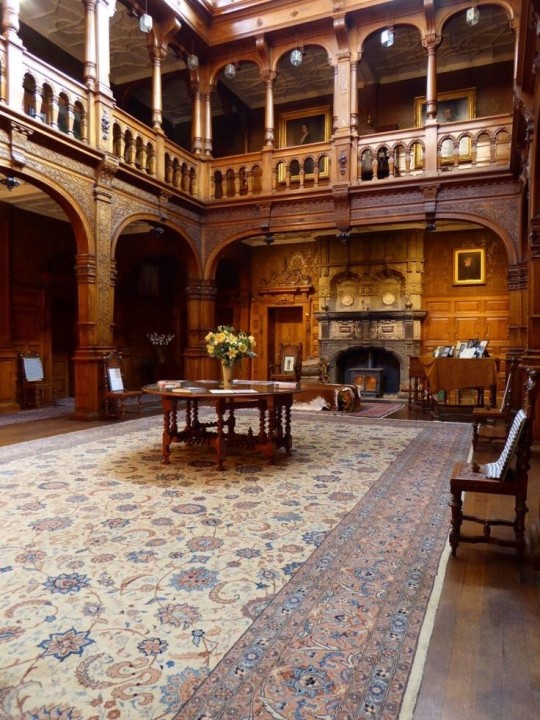
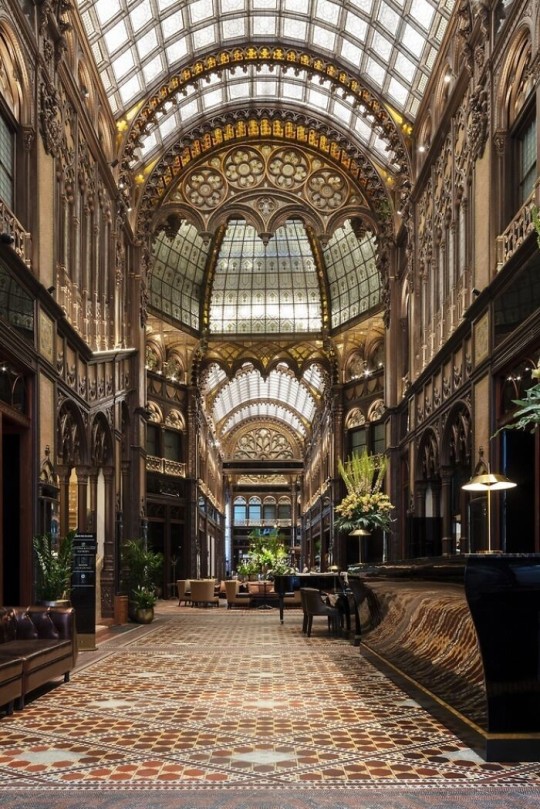
As a followup to the very popular post on architecture, I decided to add onto it by exploring the interior of each movement and the different design techniques and tastes of each era. This post at be helpful for historical fiction, fantasy or just a long read when you're bored.
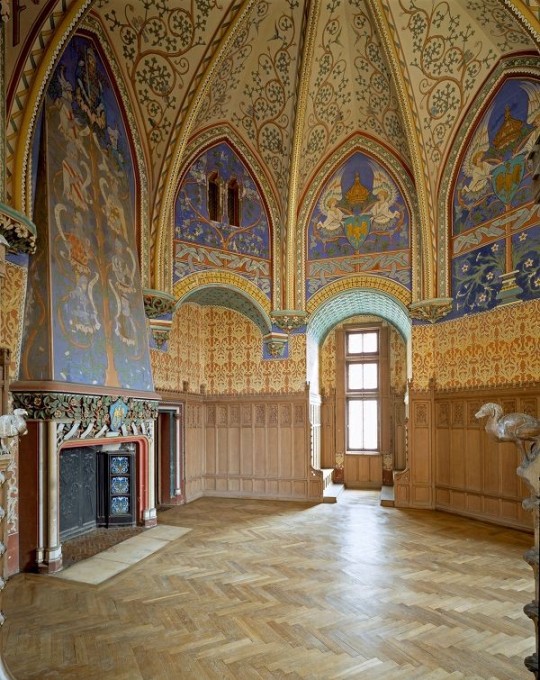


Interior Design Terms
Reeding and fluting: Fluting is a technique that consists a continuous pattern of concave grooves in a flat surface across a surface. Reeding is it's opposite.
Embossing: stamping, carving or moulding a symbol to make it stand out on a surface.
Paneling: Panels of carved wood or fabric a fixed to a wall in a continuous pattern.
Gilding: the use of gold to highlight features.
Glazed Tile: Ceramic or porcelain tiles coated with liquid coloured glass or enamel.
Column: A column is a pillar of stone or wood built to support a ceiling. We will see more of columns later on.
Bay Window: The Bay Window is a window projecting outward from a building.
Frescos: A design element of painting images upon wet plaster.
Mosaic: Mosaics are a design element that involves using pieces of coloured glass and fitted them together upon the floor or wall to form images.
Mouldings: ornate strips of carved wood along the top of a wall.
Wainscoting: paneling along the lower portion of a wall.
Chinoiserie: A European take on East Asian art. Usually seen in wallpaper.
Clerestory: A series of eye-level windows.
Sconces: A light fixture supported on a wall.
Niche: A sunken area within a wall.
Monochromatic: Focusing on a single colour within a scheme.
Ceiling rose: A moulding fashioned on the ceiling in the shape of a rose usually supporting a light fixture.
Baluster: the vertical bars of a railing.
Façade: front portion of a building
Lintel: Top of a door or window.
Portico: a covered structure over a door supported by columns
Eaves: the part of the roof overhanging from the building
Skirting: border around lower length of a wall
Ancient Greece
Houses were made of either sun-dried clay bricks or stone which were painted when they dried. Ground floors were decorated with coloured stones and tiles called Mosaics. Upper level floors were made from wood. Homes were furnished with tapestries and furniture, and in grand homes statues and grand altars would be found. Furniture was very skillfully crafted in Ancient Greece, much attention was paid to the carving and decoration of such things. Of course, Ancient Greece is ancient so I won't be going through all the movements but I will talk a little about columns.
Doric: Doric is the oldest of the orders and some argue it is the simplest. The columns of this style are set close together, without bases and carved with concave curves called flutes. The capitals (the top of the column) are plain often built with a curve at the base called an echinus and are topped by a square at the apex called an abacus. The entablature is marked by frieze of vertical channels/triglyphs. In between the channels would be detail of carved marble. The Parthenon in Athens is your best example of Doric architecture.
Ionic: The Ionic style was used for smaller buildings and the interiors. The columns had twin volutes, scroll-like designs on its capital. Between these scrolls, there was a carved curve known as an egg and in this style the entablature is much narrower and the frieze is thick with carvings. The example of Ionic Architecture is the Temple to Athena Nike at the Athens Acropolis.
Corinthian: The Corinthian style has some similarities with the Ionic order, the bases, entablature and columns almost the same but the capital is more ornate its base, column, and entablature, but its capital is far more ornate, commonly carved with depictions of acanthus leaves. The style was more slender than the others on this list, used less for bearing weight but more for decoration. Corinthian style can be found along the top levels of the Colosseum in Rome.
Tuscan: The Tuscan order shares much with the Doric order, but the columns are un-fluted and smooth. The entablature is far simpler, formed without triglyphs or guttae. The columns are capped with round capitals.
Composite: This style is mixed. It features the volutes of the Ionic order and the capitals of the Corinthian order. The volutes are larger in these columns and often more ornate. The column's capital is rather plain. for the capital, with no consistent differences to that above or below the capital.
Ancient Rome
Rome is well known for its outward architectural styles. However the Romans did know how to add that rizz to the interior. Ceilings were either vaulted or made from exploded beams that could be painted. The Romans were big into design. Moasics were a common interior sight, the use of little pieces of coloured glass or stone to create a larger image. Frescoes were used to add colour to the home, depicting mythical figures and beasts and also different textures such as stonework or brick. The Romans loved their furniture. Dining tables were low and the Romans ate on couches. Weaving was a popular pastime so there would be tapestries and wall hangings in the house. Rich households could even afford to import fine rugs from across the Empire. Glass was also a feature in Roman interior but windows were usually not paned as large panes were hard to make. Doors were usually treated with panels that were carved or in lain with bronze.
Ancient Egypt
Egypt was one of the first great civilisations, known for its immense and grand structures. Wealthy Egyptians had grand homes. The walls were painted or plastered usually with bright colours and hues. The Egyptians are cool because they mapped out their buildings in such a way to adhere to astrological movements meaning on special days if the calendar the temple or monuments were in the right place always. The columns of Egyptian where thicker, more bulbous and often had capitals shaped like bundles of papyrus reeds. Woven mats and tapestries were popular decor. Motifs from the river such as palms, papyrus and reeds were popular symbols used.
Ancient Africa
African Architecture is a very mixed bag and more structurally different and impressive than Hollywood would have you believe. Far beyond the common depictions of primitive buildings, the African nations were among the giants of their time in architecture, no style quite the same as the last but just as breathtaking.
Rwandan Architecture: The Rwandans commonly built of hardened clay with thatched roofs of dried grass or reeds. Mats of woven reeds carpeted the floors of royal abodes. These residences folded about a large public area known as a karubanda and were often so large that they became almost like a maze, connecting different chambers/huts of all kinds of uses be they residential or for other purposes.
Ashanti Architecture: The Ashanti style can be found in present day Ghana. The style incorporates walls of plaster formed of mud and designed with bright paint and buildings with a courtyard at the heart, not unlike another examples on this post. The Ashanti also formed their buildings of the favourite method of wattle and daub.
Nubian Architecture: Nubia, in modern day Ethiopia, was home to the Nubians who were one of the world's most impressive architects at the beginning of the architecture world and probably would be more talked about if it weren't for the Egyptians building monuments only up the road. The Nubians were famous for building the speos, tall tower-like spires carved of stone. The Nubians used a variety of materials and skills to build, for example wattle and daub and mudbrick. The Kingdom of Kush, the people who took over the Nubian Empire was a fan of Egyptian works even if they didn't like them very much. The Kushites began building pyramid-like structures such at the sight of Gebel Barkal
Japanese Interiors
Japenese interior design rests upon 7 principles. Kanso (簡素)- Simplicity, Fukinsei (不均整)- Asymmetry, Shizen (自然)- Natural, Shibumi (渋味) – Simple beauty, Yugen (幽玄)- subtle grace, Datsuzoku (脱俗) – freedom from habitual behaviour, Seijaku (静寂)- tranquillity.
Common features of Japanese Interior Design:
Shoji walls: these are the screens you think of when you think of the traditional Japanese homes. They are made of wooden frames, rice paper and used to partition
Tatami: Tatami mats are used within Japanese households to blanket the floors. They were made of rice straw and rush straw, laid down to cushion the floor.
Genkan: The Genkan was a sunken space between the front door and the rest of the house. This area is meant to separate the home from the outside and is where shoes are discarded before entering.
Japanese furniture: often lowest, close to the ground. These include tables and chairs but often tanked are replaced by zabuton, large cushions. Furniture is usually carved of wood in a minimalist design.
Nature: As both the Shinto and Buddhist beliefs are great influences upon architecture, there is a strong presence of nature with the architecture. Wood is used for this reason and natural light is prevalent with in the home. The orientation is meant to reflect the best view of the world.
Islamic World Interior
The Islamic world has one of the most beautiful and impressive interior design styles across the world. Colour and detail are absolute staples in the movement. Windows are usually not paned with glass but covered in ornate lattices known as jali. The jali give ventilation, light and privacy to the home. Islamic Interiors are ornate and colourful, using coloured ceramic tiles. The upper parts of walls and ceilings are usually flat decorated with arabesques (foliate ornamentation), while the lower wall areas were usually tiled. Features such as honeycombed ceilings, horseshoe arches, stalactite-fringed arches and stalactite vaults (Muqarnas) are prevalent among many famous Islamic buildings such as the Alhambra and the Blue Mosque.
Byzantine (330/395–1453 A. D)
The Byzantine Empire or Eastern Roman Empire was where eat met west, leading to a melting pot of different interior designs based on early Christian styles and Persian influences. Mosaics are probably what you think of when you think of the Byzantine Empire. Ivory was also a popular feature in the Interiors, with carved ivory or the use of it in inlay. The use of gold as a decorative feature usually by way of repoussé (decorating metals by hammering in the design from the backside of the metal). Fabrics from Persia, heavily embroidered and intricately woven along with silks from afar a field as China, would also be used to upholster furniture or be used as wall hangings. The Byzantines favoured natural light, usually from the use of copolas.
Indian Interiors
India is of course, the font of all intricate designs. India's history is sectioned into many eras but we will focus on a few to give you an idea of prevalent techniques and tastes.
The Gupta Empire (320 – 650 CE): The Gupta era was a time of stone carving. As impressive as the outside of these buildings are, the Interiors are just as amazing. Gupta era buildings featured many details such as ogee (circular or horseshoe arch), gavaksha/chandrashala (the motif centred these arches), ashlar masonry (built of squared stone blocks) with ceilings of plain, flat slabs of stone.
Delhi Sultanate (1206–1526): Another period of beautifully carved stone. The Delhi sultanate had influence from the Islamic world, with heavy uses of mosaics, brackets, intricate mouldings, columns and and hypostyle halls.
Mughal Empire (1526–1857): Stonework was also important on the Mughal Empire. Intricately carved stonework was seen in the pillars, low relief panels depicting nature images and jalis (marble screens). Stonework was also decorated in a stye known as pietra dura/parchin kari with inscriptions and geometric designs using colored stones to create images. Tilework was also popular during this period. Moasic tiles were cut and fitted together to create larger patters while cuerda seca tiles were coloured tiles outlined with black.
Chinese Interiors
Common features of Chinese Interiors
Use of Colours: Colour in Chinese Interior is usually vibrant and bold. Red and Black are are traditional colours, meant to bring luck, happiness, power, knowledge and stability to the household.
Latticework: Lattices are a staple in Chinese interiors most often seen on shutters, screens, doors of cabinets snf even traditional beds.
Lacquer: Multiple coats of lacquer are applied to furniture or cabinets (now walls) and then carved. The skill is called Diaoqi (雕漆).
Decorative Screens: Screens are used to partition off part of a room. They are usually of carved wood, pained with very intricate murals.
Shrines: Spaces were reserved on the home to honour ancestors, usually consisting of an altar where offerings could be made.
Of course, Chinese Interiors are not all the same through the different eras. While some details and techniques were interchangeable through different dynasties, usually a dynasty had a notable style or deviation. These aren't all the dynasties of course but a few interesting examples.
Song Dynasty (960–1279): The Song Dynasty is known for its stonework. Sculpture was an important part of Song Dynasty interior. It was in this period than brick and stone work became the most used material. The Song Dynasty was also known for its very intricate attention to detail, paintings, and used tiles.
Ming Dynasty(1368–1644): Ceilings were adorned with cloisons usually featuring yellow reed work. The floors would be of flagstones usually of deep tones, mostly black. The Ming Dynasty favoured richly coloured silk hangings, tapestries and furnishings. Furniture was usually carved of darker woods, arrayed in a certain way to bring peace to the dwelling.
Han Dynasty (206 BC-220 AD): Interior walls were plastered and painted to show important figures and scenes. Lacquer, though it was discovered earlier, came into greater prominence with better skill in this era.
Tang Dynasty (618–907) : The colour palette is restrained, reserved. But the Tang dynasty is not without it's beauty. Earthenware reached it's peak in this era, many homes would display fine examples as well. The Tang dynasty is famous for its upturned eaves, the ceilings supported by timber columns mounted with metal or stone bases. Glazed tiles were popular in this era, either a fixed to the roof or decorating a screen wall.
Romanesque (6th -11th century/12th)
Romanesque Architecture is a span between the end of Roman Empire to the Gothic style. Taking inspiration from the Roman and Byzantine Empires, the Romanesque period incorporates many of the styles. The most common details are carved floral and foliage symbols with the stonework of the Romanesque buildings. Cable mouldings or twisted rope-like carvings would have framed doorways. As per the name, Romansque Interiors relied heavily on its love and admiration for Rome. The Romanesque style uses geometric shapes as statements using curves, circles snf arches. The colours would be clean and warm, focusing on minimal ornamentation.
Gothic Architecture (12th Century - 16th Century)
The Gothic style is what you think of when you think of old European cathedrals and probably one of the beautiful of the styles on this list and one of most recognisable. The Gothic style is a dramatic, opposing sight and one of the easiest to describe. Decoration in this era became more ornate, stonework began to sport carving and modelling in a way it did not before. The ceilings moved away from barreled vaults to quadripartite and sexpartite vaulting. Columns slimmed as other supportive structures were invented. Intricate stained glass windows began their popularity here. In Gothic structures, everything is very symmetrical and even.
Mediaeval (500 AD to 1500)
Interiors of mediaeval homes are not quite as drab as Hollywood likes to make out. Building materials may be hidden by plaster in rich homes, sometimes even painted. Floors were either dirt strewn with rushes or flagstones in larger homes. Stonework was popular, especially around fireplaces. Grand homes would be decorated with intricate woodwork, carved heraldic beasts and wall hangings of fine fabrics.
Renaissance (late 1300s-1600s)
The Renaissance was a period of great artistry and splendor. The revival of old styles injected symmetry and colour into the homes. Frescoes were back. Painted mouldings adorned the ceilings and walls. Furniture became more ornate, fixed with luxurious upholstery and fine carvings. Caryatids (pillars in the shape of women), grotesques, Roman and Greek images were used to spruce up the place. Floors began to become more intricate, with coloured stone and marble. Modelled stucco, sgraffiti arabesques (made by cutting lines through a layer of plaster or stucco to reveal an underlayer), and fine wall painting were used in brilliant combinations in the early part of the 16th century.
Tudor Interior (1485-1603)
The Tudor period is a starkly unique style within England and very recognisable. Windows were fixed with lattice work, usually casement. Stained glass was also in in this period, usually depicting figures and heraldic beasts. Rooms would be panelled with wood or plastered. Walls would be adorned with tapestries or embroidered hangings. Windows and furniture would be furnished with fine fabrics such as brocade. Floors would typically be of wood, sometimes strewn with rush matting mixed with fresh herbs and flowers to freshen the room.
Baroque (1600 to 1750)
The Baroque period was a time for splendor and for splashing the cash. The interior of a baroque room was usually intricate, usually of a light palette, featuring a very high ceiling heavy with detail. Furniture would choke the room, ornately carved and stitched with very high quality fabrics. The rooms would be full of art not limited to just paintings but also sculptures of marble or bronze, large intricate mirrors, moldings along the walls which may be heavily gilded, chandeliers and detailed paneling.
Victorian (1837-1901)
We think of the interiors of Victorian homes as dowdy and dark but that isn't true. The Victorians favoured tapestries, intricate rugs, decorated wallpaper, exquisitely furniture, and surprisingly, bright colour. Dyes were more widely available to people of all stations and the Victorians did not want for colour. Patterns and details were usually nature inspired, usually floral or vines. Walls could also be painted to mimic a building material such as wood or marble and most likely painted in rich tones. The Victorians were suckers for furniture, preferring them grandly carved with fine fabric usually embroidered or buttoned. And they did not believe in minimalism. If you could fit another piece of furniture in a room, it was going in there. Floors were almost eclusively wood laid with the previously mentioned rugs. But the Victorians did enjoy tiled floors but restricted them to entrances. The Victorians were quite in touch with their green thumbs so expect a lot of flowers and greenery inside. with various elaborately decorated patterned rugs. And remember, the Victorians loved to display as much wealth as they could. Every shelf, cabinet, case and ledge would be chocked full of ornaments and antiques.
Edwardian/The Gilded Age/Belle Epoque (1880s-1914)
This period (I've lumped them together for simplicity) began to move away from the deep tones and ornate patterns of the Victorian period. Colour became more neutral. Nature still had a place in design. Stained glass began to become popular, especially on lampshades and light fixtures. Embossing started to gain popularity and tile work began to expand from the entrance halls to other parts of the house. Furniture began to move away from dark wood, some families favouring breathable woods like wicker. The rooms would be less cluttered.
Art Deco (1920s-1930s)
The 1920s was a time of buzz and change. Gone were the refined tastes of the pre-war era and now the wow factor was in. Walls were smoother, buildings were sharper and more jagged, doorways and windows were decorated with reeding and fluting. Pastels were in, as was the heavy use of black and white, along with gold. Mirrors and glass were in, injecting light into rooms. Gold, silver, steel and chrome were used in furnishings and decor. Geometric shapes were a favourite design choice. Again, high quality and bold fabrics were used such as animal skins or colourful velvet. It was all a rejection of the Art Noveau movement, away from nature focusing on the man made.
Modernism (1930 - 1965)
Modernism came after the Art Deco movement. Fuss and feathers were out the door and now, practicality was in. Materials used are shown as they are, wood is not painted, metal is not coated. Bright colours were acceptable but neutral palettes were favoured. Interiors were open and favoured large windows. Furniture was practical, for use rather than the ornamentation, featuring plain details of any and geometric shapes. Away from Art Deco, everything is straight, linear and streamlined.
#This took forever#I'm very tired#But enjoy#I covered as much as I could find#Fantasy Guide to interiors#interior design#Architecture#writings#writing resources#Writing reference#Writing advice#Writer's research#writing research#Writer's rescources#Writing help#Mediaeval#Renaissance#Chinese Interiors#Japanese Interiors#Indian interiors#writing#writeblr#writing reference#writing advice#writer#spilled words#writers
3K notes
·
View notes
Text
Brittani Locke, the visionary artist behind The Soft Asylum, specializes in the ancient craft of marbling. Her creations include hand-marbled textiles, paper, and fashion accessories, each distinguished by its distinctive patterns and vibrant hues.
Brittani blends traditional marbling methods from regions like Japan, China, Turkey, and the Silk Road with her own creative twists. Her technique involves floating layers of paint on a liquid base, allowing the fabric or paper to capture the intricate designs as it's dipped. This method guarantees that every piece is truly one-of-a-kind, making each item a unique artistic statement.
#asylum#textiles#artwork#traditional art#creative#beautiful#scarves#fabric#paper#prints#Brittani Locke
874 notes
·
View notes
Text
𝐀𝐌𝐁𝐈𝐕𝐀𝐋𝐄𝐍𝐂𝐄 - XV

Chapter XV: Wouldn't You Like

. Summary: Despite your brother's insistence, you stubbornly decided to join him and his men in the war. Now, are you prepared to face the consequences of your actions? . Pairing: Various x Fem! Reader . Warnings: drugs (holy moly!), non-sexual nudity (barely described) . Notes: Sorry it took so long 🥺

Previous chapter │ Next chapter
Masterlist

The palace halls stretched far beyond what you could have imagined, a seemingly endless expanse of elegance and mystery. Vines wove their way up marble columns, their emerald tendrils twisting like delicate fingers, while flowers you had never seen before bloomed in breathtaking displays of colour. They extended through the halls as though they had grown naturally, yet at the same time, their arrangement seemed deliberate, as if the palace itself had designed them with purpose.
Every turn you took left you more and more disoriented than the last. You could only wonder how those who lived here managed to navigate it so effortlessly—it felt less like a palace and more like a labyrinth. Not even the winding corridors of the palace you had once called home could compare to the intricate twists and turns you were forced to weave through now.
Occasionally, you passed other nymphs moving gracefully through the halls, their ethereal presence only adding to the dreamlike atmosphere. Some carried woven baskets in the crooks of their arms, filled with items unknown to you, while others strolled in pairs or small groups, lost in quiet conversation. Regardless of their activity, their reaction to you remained the same: a fleeting look of curiosity, followed by a polite smile and a nod of acknowledgment before they continued on their way.
Choosing to ignore the stares, you focused on the nymph leading you. You kept a careful distance, staying far enough behind that you could bolt if necessary. Trust did not come easily to you, not here, not yet. From your vantage point, you could only see her back, but that alone told you plenty. Her hair was a cascading mass of curls, an orangey-red hue that shimmered like embers in the soft light filtering through the palace. The sheer length of it was impressive, reaching all the way down to her waist, and it was thick—voluminous in a way that made you wonder how long it had taken to grow. Nestled within her curls were flowers, some woven into tiny braids that were sparsely scattered throughout her hair, while others appeared to be placed at random, yet somehow remained perfectly in place, untouched by movement. Even as she walked, her steps light and almost bouncing, not a single petal fell.
Her attire was just as intricate. She wore a finely crafted chiton, its fabric flowing like liquid with every movement. The bottom edges were embroidered with swirling golden patterns, shimmering each time the material shifted. She was barefoot, though by now, you had come to suspect that where you were, shoes were not a necessity. Perhaps this was meant to be a sanctuary—a safe haven at best, or a cult at worst. Either way, you weren't letting your guard down.
Every so often, she glanced back over her shoulder at you, as if checking to make sure you were still following. These quick glances allowed you brief glimpses of her face—soft freckles dusting her cheeks, her delicate features framed by her fiery curls, and striking baby-blue eyes that locked onto yours for a fleeting moment before turning forward again. You were sure she could navigate these halls blindfolded.
Eventually, you arrived at a room. She opened the door with ease, holding it ajar as she waited for you to step inside. Hesitation settled in your gut like a heavy stone. Your fight-or-flight instincts flared, and gods, how you wished you had your sword right now. Still, you forced yourself to enter.
The room was narrow but cozy, bathed in the soft glow of natural light from a large, arched window directly ahead. Shelves lined the walls, stacked with neatly folded fabrics in a breathtaking spectrum of colors. Some gleamed with a silk-like sheen, while others were thicker, woven from coarser materials. Opposite the shelves, baskets overflowed with clothing—some wrinkled and in need of care, others draped haphazardly, as if recently discarded. The air carried the faintest hint of lavender, mixing with the subtle scent of linen and aged wood.
"Choose one." The nymph said behind you, propping the door open to prevent it from shutting completely.
You turned to look at her, confusion knitting your brows.
"I'm sorry?" Your eyes followed her as she moved effortlessly into the room, almost gliding. You studied her movements, trying to decipher her meaning.
She chuckled softly, bringing a hand to her mouth. Embarrassment prickled at your skin. You weren't sure what she was expecting you to do, but it felt like something obvious—like you had somehow missed an unspoken rule. Heat bubbled in your chest and quickly crept up your neck to your face.
She gestured with both hands toward the shelves of fabric. "You can choose whichever one you'd like."
You glanced at the shelves, then back at her.
"...Why?"
She tilted her head slightly, as if the answer should have been apparent. "You can't tell me that wearing that is comfortable. It looks like it's been through Hades itself."
Oh. That made sense now. She wanted you to pick something to wear.
And what was it with everyone insulting your clothing today?
Noticing your silence, she arched an eyebrow. "You do know what clothes are... don't you?"
"Yes!" The word came out far too quickly, and you cleared your throat, trying to salvage your dignity. "Yes, I know what clothes are."
"Well then, pick one."
Turning your full attention to the fabric, you hesitated. The sheer variety was overwhelming. After years of wearing the same few options, how were you supposed to decide now?
Blue? No, it reminded you too much of the sea, the wound still raw and aching.
Red? No, that damned eye still plagued your dreams.
So, instead, you reached for the one closest to you without thinking. It was a soft, barely-there shade of pink, the color so delicate it seemed to fade into the light. Your fingers brushed over the fabric, and it was softer than you expected, light yet durable. It felt... right. Safe. Familiar, in a way you couldn't quite place.
Perhaps that was enough.
"Are you sure?"
"Yes?"
"You don't sound sure."
"I was until you asked me."
She just chuckled, clearly amused, and walked over to one of the baskets filled with clothes waiting to be washed. She lifted it effortlessly into her arms, moving with the kind of practiced ease that suggested she had done this a thousand times before.
"Come." She said simply before turning on her heel and heading toward the door, fully expecting you to follow without question.
You stood frozen for a second, processing the sudden shift, before realizing she was already halfway down the hall. Letting out a breath, you quickly trotted after her, catching up in just a few strides. Even though some part of you still urged you to stay behind her, to keep a safe distance, you ignored it completely and matched her pace, walking beside her instead.
"I'm sorry, um..." You trailed off, suddenly aware that you didn't know her name.
"Aora." She answered without even glancing at you.
"Aora..." You repeated, testing the name on your tongue. You hesitated before continuing, "Could I know where you're taking me?"
"Well, you need a bath, and since I have things to wash, I figured I might as well take care of that too."
She led you through the palace, down a hallway that seemed to stretch longer than it should have, until finally, you reached the back of the structure. Enormous open doors led to the outside, where the sight before you made you stop in your tracks.
The place was breathtaking.
A natural spring stretched out before you, its water so clear it looked almost unreal. The surface shimmered under the sunlight, reflecting the towering trees that surrounded it like a protective barrier. Their branches intertwined above, forming a loose canopy that filtered the light into dappled golden patches across the grass and water. Wildflowers of every color bloomed in clusters along the water's edge, their petals dancing in the soft breeze. The air smelled fresh—earthy, yet faintly floral, with a trace of salt carried from the distant sea. It was secluded, untouched, and for the first time since you arrived, you felt the smallest sense of peace.
There was no one else here. No hidden figures lurking in the shadows, no watching eyes. Just you, Aora, and the gentle sound of rippling water.
Aora made her way toward a large rock to the right, setting her basket down. When she didn't hear your footsteps on the grass behind her, she turned to look at you, one brow raised.
"Well? What are you waiting for? I won't look, I promise."
You swallowed, mustering the courage to step closer to the water. Anxiety bubbled in your chest, a lingering hesitation you couldn't quite shake. Slowly, you set the article of clothing down on a nearby rock near where you planned to bathe. Your gaze flickered to Aora once more, checking to see if she was watching. She wasn't—completely lost in her own world, preparing everything for her own task.
Still, you hesitated, scanning the treeline, searching for anyone you might have missed. But there was no one.
Taking a deep breath, you stripped, pausing briefly to test the lake's bottom with your foot. The smooth stones beneath the surface felt firm, undisturbed. Assured that nothing lurked unseen, you placed your discarded clothes beside your new ones and stepped in, submerging yourself in one swift motion.
The water enveloped you instantly, a warmth that caught you off guard. It wasn't scalding, nor unnaturally hot—just pleasantly, soothingly warm, the perfect contrast to the tension coiled in your muscles. As you sank deeper, letting the water reach your shoulders, the tightness in your body gradually melted away. A breath you hadn't realized you were holding slipped from your lips. For the first time since you arrived, your mind felt quiet.
You floated there for a moment, staring up at the canopy of trees above, processing everything.
How had a group of people survived here, on an island in the middle of nowhere? How long had they lived like this? Why were they here?
And what was the deal with Circe?
The questions nagged at you, but one stood out above the rest.
Turning your head slightly, you called out. "Aora?"
"Hm?" she responded without looking up, focused on scrubbing one of the garments from her basket.
"This place... what exactly is it?" You hesitated before clarifying. "How is there a whole group of you out here? Why?"
Aora didn't answer right away. Instead, she wrung out the fabric in her hands, watching as the water dripped back into the lake. When she finally spoke, her voice was calm, assured.
"It's a safe haven." she said simply. "Lady Circe gave us a home when we had nowhere else to go. She helped us through things no one else would. We trust her. I'm sure you will too."
There was no doubt in her tone. No hesitation.
A safe haven.
You weren't sure how to feel about that.
Some part of you wanted to believe her, to let your guard down just a little. But another part, the part that had kept you alive for this long, still whispered warnings in the back of your mind.
A slight unease settled in your stomach. Once you were finished, you'd have to talk to her—thank her, clear up the misunderstanding, and then regroup with the rest.
You said nothing, only sinking a little deeper into the water, letting the warmth soothe the questions that still lingered.
For now, that answer would have to be enough.
──────🐷──────
Odysseus felt a storm brewing inside him, emotions clashing and tangling in a way he couldn't fully comprehend. They swelled, pressing against his ribs, ready to explode and send him crumbling.
He was pissed. Furious that Eurylochus had the audacity to defy the only direct order that truly mattered to him. It had been simple—do not let his sister out of his sight. Do not let her get hurt. And yet, here they were. Eurylochus had failed something so basic, so vital, and now you were missing. He clenched his fists, nails digging into his palms. The more he thought about it, the more memories surfaced—how you had been even as a child, always slipping away, always pushing boundaries. Maybe he should've known better. Maybe, deep down, he had.
He was exhausted. It wasn't just the kind of exhaustion that weighed on his limbs, slowing his every step—it was bone-deep, soul-deep, a weariness that blurred his thoughts and made his muscles feel like lead. His body ached from endless battles, from sleepless nights, from carrying the weight of too many losses. But more than anything, he was tired of fighting battles he wasn't sure he could win.
How did he even think he would defeat this woman?
All he had was his sword and his wit. And what use was a sword against someone who could turn men into pigs? Who knew what else she could do? As for his wit—well, it had failed him more than once lately. Once, his words had been his greatest weapon, a tool sharper than any blade, capable of bending even the most stubborn minds to his will. But ever since that happened, his silver tongue seemed to do nothing but twist the knife further. Every attempt at reasoning with an enemy had only led to more disaster.
All he wanted was to reach Ithaca. To hold his son in his arms, press his forehead to his wife's, and finally—finally—collapse into their bed, safe and whole. But fate seemed determined to pull him further and further from home.
He was frustrated—frustrated with you.
You had been stubborn and reckless since the moment he first laid eyes on you. As a child, it had been adorable, the way you would cause mischief and grin your way out of trouble. But you weren't a child anymore. You were a soldier, one of his men, and it was time you started acting like it. You needed to learn to take orders, to respect him as more than just your brother. He wouldn't always be there to save you. How many times had he told you that? How many times had you ignored him? It was infuriating. When he found you, he was going to make damn sure you understood—whether you liked it or not.
If he found you.
And that was the worst part of all. Because underneath the anger, the frustration, the exhaustion—he was scared.
Gods, he hated admitting it, even to himself, but fear was curling in his gut like a snake. He was terrified of what he would find when he reached this so-called palace. Were his men hurt? Were they even alive? Were you alive?
His breath came unevenly at the thought.
What if something had happened to you? What if he was too late? What if—No. Enough.
You were alive. You had to be. He repeated it like a mantra, like a prayer, forcing himself to believe it. You were alive, and when he found you, you were going to get the scolding of a lifetime.
He had made a decision. He needed to be sterner with you. If you wanted to be treated as an equal to his men, then that was exactly how he would treat you. If you refused to follow orders, you were out. He wasn't about to let you cause more casualties just because you couldn't control yourself.
...And yet, a whisper of doubt slithered into his mind.
That's what you wanted, wasn't it? To be treated as an equal?
Then so be it.
Odysseus exhaled sharply, shaking his head. His mind wandered back to Eurylochus' words—how that woman had taken down half his men in mere seconds. Through trickery, sure, but still. It was unsettling. She had magic, something he had no defense against. How was he supposed to defeat her?
He supposed he could try charm, but that was risky. Considering what she had done to his men, he wasn't about to tempt fate. He had no desire to end up as a pig himself. That thought alone had him gritting his teeth. His men were idiots. What kind of respectable man fell for a woman's flattery so easily? He coul dunderstand why she had seen them as pigs in the first place.
His spiraling thoughts were interrupted by a sudden rustling above him.
Leaves shuddered, and something that sounded almost like a bird's cackle echoed through the trees.
Normally, he wouldn't have given it a second thought—just the wilderness being the wilderness. But something about this sound was off. It was unnatural, something he couldn't quite place, and his instincts screamed at him not to trust it.
He stopped dead in his tracks, eyes snapping to the towering trees above, scanning for movement. His grip tightened around the hilt of his sword.
Silence.
Then—the sound again. This time, from behind him.
He turned sharply, but there was nothing.
A slow, creeping unease settled over him. He knew he wasn't imagining it. Something was there, moving, circling. Watching.
Then, it came again, this time from his right.
Odysseus moved faster now, his head snapping toward the sound, but still, he saw nothing.
A voice sliced through the air, smooth and amused.
"I must say, what a brilliant speech you gave back there. Truly admirable."
His body tensed, every muscle coiled like a drawn bowstring. The voice—it was coming from everywhere. Nowhere?. It filled the air around him, slipping through the trees, slithering into his ears as if the very wind carried it.
His grip on his sword tightened.
"Who goes there?" His voice was firm, demanding.
"Don't worry, I'm just a friend wanting to help."
The words were meant to be reassuring, but they had the opposite effect. Odysseus only tensed further, his grip on his sword tightening. If anything, that cryptic response put him more on edge. His brows knitted together as he remained silent, waiting for the voice to reveal more.
"You know, Circe's not a foe easily beaten. You'll need help. A blessing, if you will. Divine intervention. And who better to lend a hand than a certain god?"
At the mention of a higher being, Odysseus' body went rigid. A god.
That single word sent a shiver down his spine, and not in a good way. The last time he had encountered a god, it had gone horribly wrong. Poseidon had ensured his life became a waking nightmare, and the thought of another divine figure meddling in his fate was... unnerving, to say the least. His lips pressed into a tight line, his mind racing.
"Someone who's not afraid to... send a message."
The voice now came from directly beside his left ear. Too close.
Odysseus whipped his head around, eyes darting wildly, only to find nothing. His pulse quickened. The unseen presence toyed with him, shifting, flitting out of reach. Then—a tap.
Right shoulder.
He spun sharply, this time ready for a fight.
Instead, he came face to face with a man.
No, not just a man.
The figure hovered inches above the ground, clad in the garb of a traveler—flowing robes in warm hues of gold and burnt orange, a satchel slung across his chest, its contents impossibly heavy yet carried with effortless grace. His hat, tilted just enough to obscure his eyes, bore two small, feathered wings, identical to those adorning the sandals on his feet.
"Hermes." Odysseus exhaled sharply, realization dawning like a heavy weight upon him. His stomach twisted.
Even after all these years, after all he had seen—gods still unsettled him.
You'd think he would have grown accustomed to their sudden appearances, to the way they materialized out of nowhere, uninvited and all-knowing. But he hadn't. And deep down, he knew he never would.
Hermes took in Odysseus' stunned expression and threw his head back in laughter—a sharp, cackling sound, identical to the one that had followed him through the woods. A chill ran down the back of Odysseus' neck. So that had been him all along.
The god was entertained. Amused.
That, more than anything, put Odysseus on edge.
Still chuckling, Hermes draped an arm around Odysseus' shoulder, his grip far too casual for someone discussing life or death matters. "Now tell me, darling, " He began smoothly, "wouldn't you like a taste of power? To wield more than mere words? To beat her at her own game?"
Odysseus remained stiff beneath the god's touch, his mind spinning. He hated being played with, and this felt an awful lot like a game.
Hermes extended his free hand, as if striking a deal. "Trust me, you'll want my help."
Odysseus narrowed his eyes. "Why?"
Hermes let out an exaggerated sigh, as if Odysseus was being impossibly slow. Then, in a voice laced with mischief, he began listing off horrors like they were items on a menu.
"Well, for starters, she can turn you into an animal. One that'll end up on her plate if she's feeling particularly hungry."
Odysseus stiffened.
"She can make you fall hopelessly, helplessly in love with her—have you worshipping the very ground she walks on, as if she were the love of your life."
Odysseus' blood ran cold. Was that what had happened to his men? Was it magic that had lured them inside the palace? Not just temptation—but enchantment?
"And worst of all," Hermes continued, his voice dipping into something almost dark. "she can conjure up a monster—a three-headed beast that will rip you apart before you even have a chance to scream."
A heavy silence settled between them.
Odysseus swallowed hard.
He had known this would be difficult. He had known Circe was no ordinary woman. But this? If Hermes was telling the truth, then he was truly outmatched.
Hermes, sensing the shift, leaned in, his voice honeyed. "So, I'll ask again—would you like my help?"
The god extended his hand once more, fingers outstretched. Waiting.
Odysseus stared at it.
Everything in him screamed not to trust Hermes. The god was a trickster, a deceiver. His very existence revolved around twisting words and warping truths. But at the same time...
What other choice did he have?
He could not afford to fail here. His men—you—were counting on him.
His pride warred with his logic. His instinct told him to refuse, to rely on his own cunning, as he always had. But this was not a battle of blades. It was magic against man.
And he was only a man.
Slowly, Odysseus exhaled. He weighed his options, searched for an alternative, found none.
He reached out and clasped Hermes' hand.
"Yes."
The moment the word left his lips, Hermes' grin stretched impossibly wide.
Not once had the god stopped smiling, but now? Now, his delight was palpable, almost unsettling. If Odysseus wasn't already rattled by what Circe was capable of, he might have found it downright unnerving.
But there was no turning back now.
──────🐷──────
Once your bath was over, you slipped into the newly acquired chiton. The fabric was softer than anything you had worn in years, its airy weave allowing it to drape effortlessly over your skin. It moved with you, flowing freely rather than constricting, a stark contrast to the garments you had worn before—thicker, sturdier fabric built for battle, meant to endure rough training, long marches, and the ever-present threat of war.
This one was different. Gentle. Elegant.
You ran your fingers over the golden embroidery woven delicately into the hem, small intricate details that shimmered under the light. It was the kind of craftsmanship you would expect to see of a queen. It almost felt undeserved.
A simple rope, tied neatly around your waist, was the final touch.
Your hair, still damp, clung lightly to the back of your neck. You let it fall naturally over your shoulders, the cool air refreshing against your skin.
It had been so long since you'd had a bath like this—peaceful, unhurried. No shouts of men echoing around you, no need to rush before the next battle, no stale smell of sea salt and sweat clinging to your skin. You hadn't realized just how much you'd missed this.
Aora, who had been quietly finishing her task, glanced over and gave you a nod, gesturing for you to follow. She gathered the rest of the garments she had been washing and led you back into the depths of the palace.
You tried to memorize the twists and turns of the halls as you walked, noting the carved archways, the way ivy seemed to grow unchecked in some corners of the corridors, as if the palace itself was alive. But the effort was futile—Circe's home felt like a labyrinth, shifting and endless, refusing to be understood.
By the time you arrived at the courtyard, Aora turned to you.
"Stay here." She instructed. "Circe will be with you shortly."
And just like that, she disappeared into the palace once more.
You did as you were told, not daring to wander.
Instead, your gaze drifted, exploring in silence.
A flowering vine curled up one of the marble pillars beside you, its twisting tendrils creeping toward your height. The deep green leaves shimmered under the golden light, and nestled among them was a single bloom—a soft purple hue, petals unfurling like silk. You reached out without thinking, fingertips grazing the air just before touching—
A sudden chorus of squeals shattered the quiet.
You jerked back instinctively as a flurry of movement burst through the doors you had entered from.
A herd of pigs came rushing in, stumbling over one another, their distressed cries filling the air. At first, you thought they had simply escaped from a pen, but something about their movements—frantic, panicked—made your stomach twist.
Nymphs guided them across the courtyard, ensuring none broke away from the group. But as they passed, one of the pigs—small, trembling—locked eyes with you.
It stopped abruptly, squealing louder than the rest, its gaze wide and desperate.
And for a fleeting moment, your breath caught in your throat.
Because something was wrong.
It wasn't just an animal's cry. There was something in its eyes. Something... almost human.
The thought sent a chill down your spine.
Before you could process it further, a figure slid into place beside you.
A hand reached out—not harshly, but with a practiced, effortless motion—and with a simple nudge of her foot, Circe redirected the pig.
The creature hesitated, glancing between you and the sorceress before reluctantly rejoining the rest of the group, ushered along by the nymphs.
You stood frozen, watching them disappear into another chamber, heart still hammering.
Why had that pig looked at you like that?
Before you could ask, Circe plucked the flower you had been admiring earlier—the soft purple bloom, vibrant against her fingers. Without a word, she reached up and tucked it behind your ear, brushing a strand of damp hair from your face in the process.
Her touch was featherlight. Almost... gentle.
"I trust the bath was to your liking?" She mused, a knowing smile playing at her lips.
You blinked, forcing yourself to refocus. "Yes," You managed. "thank you. And for the clothing as well."
Circe waved a hand dismissively, as if the gratitude was unnecessary.
"But," You continued, shifting your weight, "I should probably head back. My brother must be worried."
Circe's expression didn't change, but there was something in her gaze that sharpened. "Your brother?"
"Yes," You nodded, straightening. "I came to this island with him and his men. He sent half of us to scout it while the others remained back. You see, we got stranded after—"
"Half of you?"
Something in her tone made you pause.
"Yes," You confirmed, though her reaction unsettled you. "I can say on behalf of all the men you took in, as well as myself, that we'd be indebted to you. We appreciate your generosity. I wish I could stay longer, but my brother—"
"We are your family now."
The words were said smoothly, effortlessly. As if they were simply true.
You stiffened. "You need to understand—those men weren't a danger to me. I chose to travel with them. All those years ago, I made that decision."
Circe tilted her head slightly. "Sometimes we think we choose things," She said, voice calm, "but in reality, we have no other option. We do it to survive."
You frowned, the weight of her words sinking into your chest.
"I understand what you're saying," You admitted, "but it doesn't apply to me. Not in this case, anyway." Your voice grew steadier. "Those men are under my brother's command. And he—"
Your lips curled slightly, determined.
"My brother would never let me get hurt. Not that I would let myself get hurt. Especially by them."
Circe regarded you carefully. "How?"
You gave her a small, almost teasing smile. "A sword and strongly worded replies are a lady's best friend."
She chuckled, a quiet, amused sound. Then, after a pause, she glanced at you, as if considering something.
"Say, dear," Circe murmured. "while you're here, would you mind teaching us some of your skills?"
Your brow arched. "Who says I'm staying?"
"You said you were hungry before, yes?" She ignored your question.
The words were casual. But there was something else underneath them, something that made your breath hitch for just a moment.
Circe smiled.
You swallowed.
Oh.
You were playing a game you hadn't even realized had begun.
──────🐷──────
Hermes rummaged through his satchel with a vigor that bordered on theatrical, his entire arm disappearing into its depths. The bag seemed bottomless, endless, filled with trinkets, scrolls, and gods only knew what else. Odysseus' patience wore thinner with each passing second.
His mind was already racing ahead, anticipating what he might find at Circe's palace.He knew he had to act fast, but here he was—waiting for a god to dig through his belongings like some absentminded merchant at the bottom of a chest.
Just as he opened his mouth to snap something impatient, Hermes let out an excited gasp.
"Here we are!" The god's voice rang with triumph.
He yanked out a delicate white flower, its thin stem arching between his fingers. The petals glowed softly, reminiscent of moonlight caught on still water. Odysseus stared, watching as Hermes turned it this way and that way, inspecting it like a jeweler assessing a fine gem.
Despite being buried under a ridiculous amount of other things, the flower remained pristine, untouched—as if the satchel itself had known to protect it.
"Behold!" Hermes declared, extending it toward Odysseus with an exaggerated flourish.
Odysseus took it, rolling it between his calloused fingers. It was... just a flower.
His brow furrowed. How was this supposed to help him?
"How is this going to—?"
"Oh, darling." Hermes chuckled, clearly amused by his confusion. "You ask, yet you hold the answer." He pointed to the root of the plant, tapping it lightly. "Here lies the power you'll need to take her on."
Odysseus frowned, bringing the plant closer to his face, inspecting the thick, knotted roots. What kind of magic did this thing hold? Was it poisonous? Was he supposed to rub it on his skin? Burn it?
Seeing his clear lack of understanding, Hermes sighed and elaborated. "Once you consume and digest it, you'll be able to manifest a being of your own creation."
Odysseus snapped his gaze back to the god, baffled. "You're bluffing."
Hermes smirked and tapped his forehead— a little too hard, causing Odysseus to flinch.
"You lack imagination, darling."
Odysseus' mind reeled. A being of his own creation? That was impossible.
Before he could voice his doubts, Hermes cut him off. "It's only for a moment, though. Until you've beaten her."
Odysseus didn't know whether to be relieved or more unnerved. This felt... too convenient. The gods never offered help for free. There was always a price.
His grip on the flower tightened. "And what do I give you in return?"
At that, Hermes cackled, his laughter echoing through the trees. "Oh, please. Just using it is enough. Believe me, darling."
That was hardly comforting.
Odysseus stared at the plant, weighing his options. This could easily be a trick—a cruel one. But at this point, what other choice did he have?
Hermes clapped his hands together, startling him from his thoughts.
"Well? What are you waiting for? Eat it."
Odysseus hesitated. "...Now?"
Hermes gave him a look. "Well, yes. You need to fully digest it, darling."
There was no point in dragging this out. Odysseus inhaled sharply, then took a bite.
Instant regret.
The moment his teeth sank into the root, a harsh bitterness flooded his mouth. It was earthy, like chewing on damp soil and tree bark, but somehow worse. The texture was fibrous, stringy, almost rubbery, forcing him to work his jaw painfully just to break it down.
His stomach immediately recoiled, his gag reflex kicking in as his throat threatened to reject the vile thing altogether. He squeezed his eyes shut, willing himself to swallow.
His eyes watered.
Hermes grinned.
"You might want to sit down for this."
Odysseus barely processed the words, but his body was already feeling... strange. His limbs felt lighter and heavier all at once, like he was floating but also being pulled downward by an unseen force.
Hermes, ever the entertainer, leaned in conspiratorially.
"Oh! And you won't guess what it's called."
Odysseus, struggling to chew a second bite, shot him a glare.
With visible effort to keep from laughing, Hermes blurted—
"Holy Moly!"
Odysseus froze mid-chew.
"...Ah?"
The absurdity of the moment was almost enough to snap him out of what was happening—almost.
Because then, the effects started to hit.
The world around him began to tilt, as if the earth itself had suddenly decided to move beneath him. Colors sharpened, sounds stretched, the rustling of leaves and the crackling of Hermes' laughter stretching unnaturally long before snapping back into place.
His body felt both detached and hyper-aware, like his nerves were vibrating under his skin. The cool evening air against his face turned to warmth, then cold again, then warm.
Hermes, now looking far too entertained, crouched beside him, resting his chin on one hand.
"Oh, this is going to be fun."
Odysseus barely registered him. His vision blurred at the edges, his mind both racing and slowing at the same time.
It was going to be a long few hours.

BONUS: A little high Ody for the road :)

. Taglist: @permanently-nothere @lemonberryberry @supernatural-bangtanboys @doodle-with-rhy @yonkersworld @pookiezme @keikeiluvyou @hornehlittleweeblet2
94 notes
·
View notes
Text


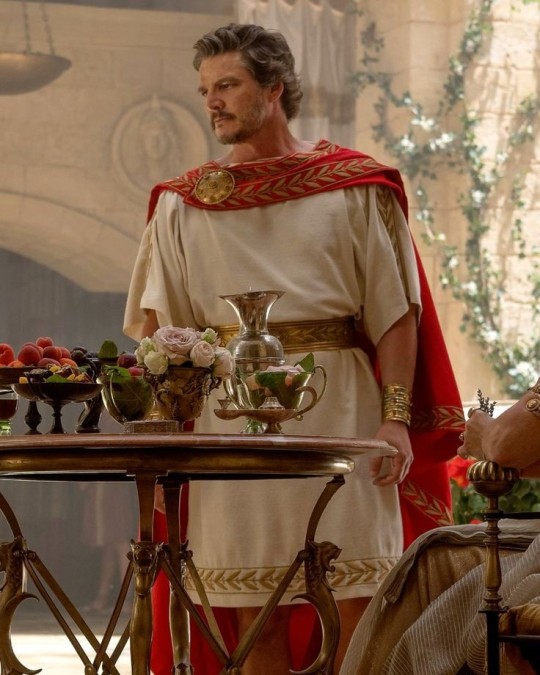
General Acacius x Isekai! Reader x emperor Geta
Words 2k
Part 1 Part 2 Part 4 Part 5
Get into the movie?What a joke Part3
The carriage came to a halt before a grand marble estate, its imposing facade gleaming in the golden sunlight. A lush garden surrounded the mansion, its paths adorned with blooming peonies and vibrant roses. The floral arrangements framed the entrance like a work of art, their delicate petals contrasting with the stoic grandeur of the house. Your eyes wandered to the gilded details embedded in the tall, spiraling columns flanking the doorway. Each column was a testament to craftsmanship, their intricate designs depicting mythical nymphs intertwined in an eternal dance.
The iron gates, crafted in ornate patterns, bore the likeness of two ethereal maidens, presumably the aforementioned nymphs. Their gazes, though forged of metal, seemed to follow your every move.
Swallowing nervously, you looked down at your hands, clenching and unclenching them. You closed your eyes for a brief moment, allowing the memories of the journey here to surface. Confusion and panic had plagued you, and though the turmoil still simmered, you had forced yourself to confront the truth.
This wasn’t a dream.
Somewhere along the way, the lines between fantasy and reality had blurred, and now you stood here, in a story you had once studied and admired. The man who had rescued you on the road—General Acacius—had called you by a name that was not your own: "Flavnia Plavcia."
The name was unfamiliar, its weight foreign, yet it resonated with an echo of significance. Flavnia. Plavcia. A woman whose story you knew not from modern tales but from the annals of Roman history. She was said to have wielded immense influence during the reigns of the emperors Geta and Caracalla.
Flavnia was a name shrouded in both admiration and infamy. Historians debated her legacy—was she a cunning survivor or a scheming villainess? According to one account, she had secured wealth and favor through relentless ambition, skillfully navigating the treacherous waters of Roman politics. She evaded countless assassination attempts, eventually retreating to Sicily, where she lived out her days.
But there was another tale—one of betrayal and tragedy. In this version, her husband had poisoned her and smuggled her lifeless body to Sicily, burying her far from her father, Cornelian, who had doted upon her.
You had studied both narratives in depth during your university years, yet neither version had provided a definitive answer. Flavnia remained an enigma—a shadowy figure from the past whose true character eluded clarity.
A Roman woman of such cunning in her time? you mused, stepping out of the carriage. Surely, even the blind would sense duplicity here.
Your musings were interrupted as the carriage door opened. A maid, dressed in simple yet pristine attire, curtsied deeply, her voice trembling with emotion.
“Lady Flavnia, welcome home,” she greeted, her eyes widening in shock as they fell upon your disheveled state. Her hand flew to her mouth as if to stifle a gasp.
“W-who did this to you, my lady?” she cried, her tone laced with both horror and concern. Her gaze flickered to your damp clothes, your tangled hair, and the traces of algae clinging stubbornly to your tresses.
Before you could respond, she had summoned more servants. They surrounded you, fussing over every detail of your appearance. Without hesitation, they led you inside, bathing you, combing the remnants of the ordeal from your hair, dressing you in finery befitting your station, and finally, offering a tray of delicacies to restore your strength.
Their care was meticulous, almost reverent. Though you uttered not a word, it became clear that these servants harbored deep loyalty to the woman they believed you to be.
---
Not long after you had settled into your quarters, the door opened abruptly. In strode a man of commanding presence, his expression a mask of fury barely concealed beneath a veneer of composure. He seated himself in a chair across from you, his elbow resting on the armrest as he propped his cheek against his knuckles.
The tension in the room was palpable.
“Point him out,” he demanded coldly, his voice low and deliberate, though it carried the weight of a tempest waiting to be unleashed. “Tell me who dared harm my daughter, and I shall see to it that he disappears from this world before the day is through.”
Your breath hitched, your eyes widening as his words struck you like a physical blow. Your hands clenched the folds of your skirt as you stared at the floor, the weight of his anger suffocating. How could you explain to him that you had no memory of the incident—at least not as Flavnia?
“I… I don’t know,” you whispered, your voice barely audible. “It’s all a blur.”
His fist came down upon the table with a resounding crack, causing you to flinch violently. His face turned crimson with rage, his dark eyes alight with an almost supernatural fire.
“This is why I should never have allowed you to attend!” he thundered, pacing the room in agitation. His fury was boundless, yet his concern was equally apparent.
The man before you was no ordinary Roman citizen. He was Cornelian—a man celebrated for his valor and unwavering dedication to Rome. His reputation as “Stompus Staptus” (the Unyielding Gate) was not merely a title but a testament to his fortitude. He had once defended the gates of Rome against relentless invaders, holding his ground for an entire year.
But to you, he was something more than a legend. He was a father—a protector whose love transcended even his allegiance to the Empire. His daughter had once dubbed him “Atius Obsidium” (Father-Protector), and that title seemed to cling to him still.
Turning back to you, he sighed heavily. His anger seemed to drain from him as his gaze softened.
“If I had known the danger, I would never have allowed you to leave,” he murmured, his voice tinged with regret. “Those insolent fools think they can harm my daughter without consequence…”
Before his anger could reignite, you rose from your seat, placing a gentle hand on his arm.
“Father,” you began softly, a faint smile tugging at your lips, “there’s no need to waste your energy on them. Instead, I would like to discuss General Acacius, who assisted me. I wish to thank him personally.”
The mention of Acacius seemed to shift the atmosphere. Cornelian studied your face, his lips twitching into a small, reluctant smile. With a nod, he placed a hand atop your head, ruffling your hair affectionately.
“You’ve always had a way with words, my clever girl,” he said, his voice tinged with pride. “Very well. We shall arrange to meet with him. He has proven himself trustworthy, and for that, I owe him my gratitude.”
With a final, reassuring pat on your head, Cornelian turned toward the door. As he reached the threshold, he glanced over his shoulder.
“Rest now, my child. Your father will see to everything.”
“And you as well,” you replied warmly, watching as the door closed behind him.
Finally alone, you let out a long breath, sinking onto the plush bedding. Wrapping your arms around a pillow, you buried your face in its softness.
“What am I supposed to do now?” you muttered to yourself, your voice muffled. “And how am I supposed to survive here without my Milo?”
You sniffled, thinking of the little golden-furred cat you had left behind. Though you knew your mother would care for him in your absence, the thought of being without him in this strange new world was almost too much to bear.
The days flowed like a gentle stream, each bringing its own discoveries. You had already wandered through every chamber of the mansion, each one adorned with opulence: golden-framed mirrors that caught every flicker of light, heavy velvet curtains embroidered with intricate patterns, and antique furniture that whispered tales of grandeur. Yet none of these treasures captivated your heart as much as the garden did—a secluded paradise where wisteria cascaded like a shimmering veil, offering cool shade from the sun’s relentless embrace. The air there was imbued with a fragrance so divine that it seemed otherworldly, and the pristine white marble paths wove through the greenery like strokes of an artist’s brush, completing the vision of Eden.
This place felt untouched by time, a sanctuary where kindness blossomed in every soul you encountered. The servants, ever loyal, treated you with a reverence that bordered on familial warmth. You were their lady, the one they had known since your earliest days. Smiling faintly, you raised a hand to wave at one of the gardeners. He responded with equal enthusiasm, his weathered face lighting up with a grin as he set aside his tools. You approached him, your thoughts already turning to the flowers.
“I’ve been wondering,” you began, your voice carrying the melody of curiosity. “Would it be suitable to plant amaryllis here? They may lack fragrance, but their beauty could complement the mimosa.”
The gardener paused, his brow furrowing as he considered your suggestion. “It’s a fine idea, my lady,” he replied, though a trace of uncertainty lingered in his tone. “Yet, I fear they might not thrive together. Such flowers, though beautiful, sometimes fail to coexist.”
You tilted your head, undeterred by his hesitation. Together, you delved into the nuances of flora, your voices blending with the rustling leaves and the distant hum of bees. Unbeknownst to you, a figure lingered nearby. Acacius stood in the shadows, his dark gaze fixed upon you.
To him, this was an unfamiliar side of you. Gone was the woman whose sharp tongue and icy demeanor he had come to expect. In her place was someone alive with passion, her every word animated by a genuine interest. She seemed brighter, almost radiant, as she discussed the nuances of flowers with the gardener. This transformation confounded him. What had changed? Or had he simply never taken the time to see this side of you?
The gardener’s voice broke his train of thought. “It’s a shame,” the man said with a sigh. “Some beauties simply cannot share the same space.”
You offered him an encouraging smile, brushing aside his doubts with a gentle wave of your hand. “Nonsense,” you replied. “We’ll find a way. Perhaps a different arrangement…”
Acacius shook his head, a faint smile tugging at his lips as he stepped forward. “Lady Plavtiana,” he called, his deep voice cutting through the garden’s tranquil atmosphere. “Might I request a moment of your time?”
Startled, you turned to face him. Your expression shifted from surprise to guarded composure, though your hands betrayed you by nervously clutching the fabric of your skirt. “General… I wasn’t expecting to see you here,” you began, searching his face for answers. “I thought my father and I were to visit you at your estate. Do you have business with him?”
A smirk played on Acacius’s lips, his dark eyes gleaming with amusement. “Indeed,” he replied. “But must you always address me so formally? We’ve known each other far too long for such titles. Simply Acacius will suffice.”
You stiffened at his words, your cheeks warming as you realized your slip. “My apologies,” you murmured, your voice barely above a whisper. Before you could say more, he noticed the subtle tremor in your hands and decided not to press further—not here, with the gardener still present.
“Regardless,” he continued smoothly, his tone gentler now, “you are correct. I am here on business with your father. However, I was hoping to speak with you… privately. If, of course, you have the time.”
His words hung in the air, a quiet challenge, as his gaze met yours and held it. The gardener, sensing the shift in atmosphere, discreetly stepped away, leaving you alone with Acacius under the canopy of wisteria
#geta x you#emperor geta x reader#emperor geta x you#geta x reader#geta#emperor geta x fem reader#emperor geta x female reader#emperor geta x y/n#general acacius x you#general acacius x reader#general acacius#acacius x reader#marcus acacius#marcus acacius x reader#gladiator 2#marcus acacius x female reader
112 notes
·
View notes
Text
𝓣HE 𝓢LYTHERIN ✶ 𝓓ORM


𝕴𝖙'𝖘 𝖓𝖔𝖙 𝖒𝖞 𝖋𝖆𝖚𝖑𝖙 𝕴'𝖒 𝖇𝖊𝖙𝖙𝖊𝖗 𝖙𝖍𝖆𝖓 𝖞𝖔𝖚.

Hidden beneath the castle, deep under the Black Lake, the Slytherin dormitories have shed their old, dreary reputation and transformed into a sleek, modern sanctuary. No longer cold and ominous, the space now radiates a refined elegance, blending old-world charm with contemporary luxury. It’s a haven for ambitious minds, a place where intelligence, creativity, and camaraderie thrive.
The Entrance:
Unlike the other houses, whose common rooms are hidden behind paintings or riddles, the Slytherin entrance remains a well-kept secret, embedded into the stone walls of the dungeons. The door is a seamless, enchanted slab of black marble veined with silver, appearing only when approached by a Slytherin. With a simple touch or a murmured password, it slides open silently, revealing the breathtaking space beyond.
The foyer is a quiet antechamber before the main common room, designed for those who need a brief moment of solitude before entering the lively hub of the house. Plush emerald benches line the walls, and soft overhead lighting casts a gentle glow over the polished black tile floor. A house crest, made of enchanted silver, shimmers on the wall, subtly shifting between different designs over the years—sometimes reflecting the faces of past Slytherin legends, sometimes morphing into a snake that slithers lazily across the surface.
──────────── · · ─ ·𖥸· ─ · · ────────────
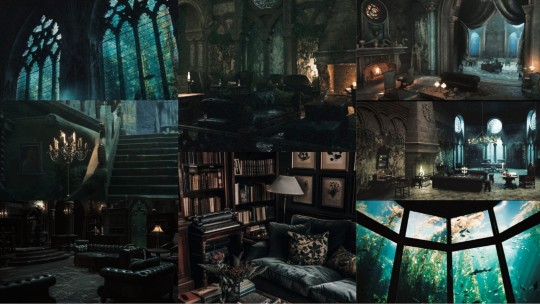
The Common Room:
Stepping into the common room is like entering a high-end lounge designed for scholars and socialites alike. The Black Lake Viewing Windows stretch from floor to ceiling, offering an uninterrupted, spellbinding view of the water beyond. Sunlight filters through in dappled beams during the day, creating a serene, ever-moving pattern across the walls. At night, the lake turns dark and mysterious, with occasional flashes of silver from passing mermaids, darting grindylows, or schools of luminescent fish.
The central seating area is designed for both comfort and conversation. Instead of rigid wooden chairs, plush velvet sectionals in deep green and charcoal gray create cozy clusters, each accompanied by polished oak coffee tables that hold floating candle sconces and stacks of books left behind by students. A massive fireplace, enchanted with cool green and blue flames, sits as the focal point of the room, casting flickering reflections across the glass windows and silver-trimmed walls.
A study alcove on the far side of the room is quieter, tucked away for those who need focus. A long, sleek ebony table runs along the wall, lined with ergonomic chairs that adjust themselves to each student’s preferred posture. Floating glass orbs provide customizable lighting, glowing softly for those pulling late-night study sessions. The surrounding bookshelves are filled with both classic wizarding texts and modern literature, spanning everything from magical law to wizarding fashion trends.
For relaxation, a leisure lounge sits opposite the study alcove, featuring an enchanted chess table, a moving dartboard that playfully dodges poor shots, and a Wizarding Wireless system that plays curated playlists based on the collective mood of the room—whether it’s instrumental music for studying or lively jazz for social evenings.
In one corner, a self-serve café station offers an array of beverages, from classic teas and butterbeer to cold brew coffee and specially crafted wizarding drinks. The station is magically replenished, ensuring that no student ever suffers through an early morning class without caffeine. Seasonal drinks rotate throughout the year—pumpkin spice brews in autumn, peppermint hot chocolate in winter, honey-infused teas in spring, and iced berry potions in summer.
Additional Exclusive Spaces:
Beyond the common room and dorms, the Slytherin quarters feature several hidden areas, reserved for house members only:
The Greenhouse Atrium – A hidden indoor garden filled with exotic plants from all over the wizarding world. Ivy-covered archways lead to a peaceful retreat where students can read, meditate, or study potions in a natural setting. Twinkling fairy lights overhead create a serene, dreamlike atmosphere.
The Lounge Bar – A sophisticated space for unwinding after classes. While it doesn’t serve alcohol, handcrafted butterbeer mocktails, chilled pumpkin juice, and sparkling potions are always on tap. Elegant yet comfortable, it’s the perfect place for deep conversations or celebratory evenings after exams.
The Duelling Room – A state-of-the-art training space for combat practice, fitness, and spellwork. Enchanted dummies, moving obstacle courses, and sparring rings allow students to refine their magical skills in a controlled environment.
The Music & Arts Studio – A soundproofed creative space equipped with enchanted instruments, a recording charm, and a small stage for performances. Whether students want to compose music, paint, or practice dramatic readings, this room is a hub for artistic expression.
──────────── · · ─ ·𖥸· ─ · · ────────────
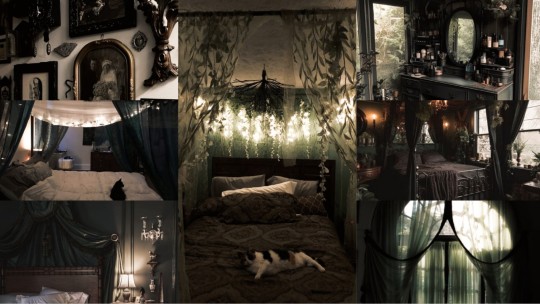
The Dormitories:
Unlike the cramped and uniform dorms of the past, the modern Slytherin dormitories have been reimagined for comfort, privacy, and personal expression. Instead of only shared rooms, students now have access to private quarters apon request.
Each student, even in shared dorms have their own rooms with beds that are king-sized, dressed in deep emerald or obsidian bedding, embroidered with silver accents. Some students prefer a sleek, minimalistic look with crisp linens and dark wood, while others decorate their spaces with fairy lights, houseplants, and velvet throws. The ceilings can be enchanted to reflect a starry night sky, rainstorms, or even the movement of the Black Lake above.
Each room features a customizable study nook, complete with a polished oak desk, floating bookshelves, and a smart magical mirror that doubles as a daily planner. A window—enchanted to show either the outside world or calming landscapes—can be adjusted depending on the student’s mood.
The wardrobes are another innovation—walk-in closets that magically organize outfits based on the day’s schedule, weather, or personal preference. The enchanted mirror inside offers styling advice and, when in a playful mood, delivers sassy commentary about outfit choices.
1. The Beds
Slytherins value both comfort and aesthetics, and their beds are a reflection of that.
Four-Poster or Canopy Options: Some students keep the traditional regal look, while others enchant their beds to hover slightly above the floor.
Self-Regulating Bedding: Enchanted to adjust to your body temperature for the perfect sleep.
Silk, velvet, or Egyptian cotton sheets, depending on personal preference.
Hidden Storage: Drawers that magically organize clothes, with an enchanted shoe rack that cleans and repairs itself overnight.
Dream Projection Feature: Some beds allow students to replay memories or visualize their dreams before sleeping.
2. Work & Study Spaces
Slytherins are strategic thinkers, so their rooms have top-tier workstations to match their ambitions.
Floating Desks that adjust to standing or sitting mode.
Spell-Proof Study Nooks for students who need to concentrate without distractions.
Holographic Notes & Book Summaries – Simply tap a book, and a glowing summary appears in the air.
Auto-Writing Quills that take dictated notes or transcribe ideas.
3. Personal Wardrobes & Vanity Areas
Walk-in Closets, with sections sorted by magical occasion (formal robes, casual wear, dueling gear, etc.).
Vanity Mirrors with Enchantment Features:
Offer styling advice and hair-styling charms.
Can alter appearances temporarily to test different looks before committing.
Self-Organizing Laundry Baskets: Clothes fold themselves and freshen up overnight.
4. Personalization & Enchanted Features
Slytherins don’t do boring. Their dorms have the coolest magical modifications, including:
Mood Lighting Charms: Adjust the lighting’s warmth and color depending on the vibe.
Personal Sound Systems: Students can play enchanted records, ambient sounds, or Muggle music through magical speakers.
Moving Artwork: Family portraits, classic wizarding art, or animated abstract designs. Some paintings even interact with students, offering advice or sarcasm depending on their enchantment.
Miniature Greenhouses: For students interested in herbology or potion ingredients, a small terrarium-style setup is available in some rooms.
5. Secret Features & Custom Spells
Because Slytherins always have a trick up their sleeve, many students add hidden elements to their rooms.
Hidden Compartment Drawers – Perfect for stashing notes, valuables, or contraband.
Private Entrance Charms – Some students enchant their doors to only open with a personalized spell or phrase.
Soundproofing Charms – For privacy, late-night study sessions, or secret conversations.
──────────── · · ─ ·𖥸· ─ · · ────────────
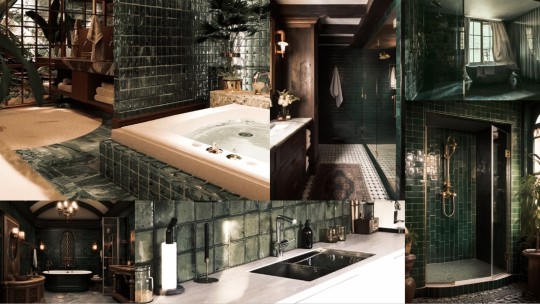
The Bathrooms:
Stepping into the Slytherin bathrooms feels like entering a high-end wizarding spa. The air is lightly scented with enchanted eucalyptus and lavender, keeping the space feeling fresh and calming. The walls are lined with dark green marble, veined with silver, and the floor tiles are temperature-controlled, ensuring that even on the coldest winter mornings, they remain warm underfoot.
Showers & Bathtubs:
Walk-in Rainfall Showers – Spacious, sleek, and enclosed in frosted glass, the showers are charmed to provide a perfect water temperature every time. Some even have illusion charms, allowing students to bathe under a "rainforest canopy" or "waterfall lagoon."
Deep Soaking Bathtubs – Large enough for full-body relaxation, these clawfoot tubs come with a variety of magical bath oils and bubbles that change scents based on mood. Some students opt for self-heating bath stones, turning their baths into a personal hot spring.
Vanity & Grooming Area
Fog-Resistant Mirrors – These enchanted mirrors provide morning affirmations or style advice, adjusting to each student’s needs.
Grooming Stations – Individual vanities stocked with self-cleaning towels, wizarding hair-care tools, and potions for styling or skincare.
Personalized Magic Lockers – Each student has a small enchanted locker where they can store toiletries programmed to open only at their touch.
Additional Features
Soft Lighting Charms – Adjustable based on mood or time of day, ensuring no harsh glares during early morning routines.
Music Charms – Optional, allowing students to play soft instrumentals, classic wizarding tunes, or even Muggle music while getting ready.
Aromatherapy Spells – Cast over the space, keeping it fresh and infused with soothing scents.
──────────── · · ─ ·𖥸· ─ · · ────────────
made by @g1rlsp1ckins
#✿𝆬 𝅄 — @g1rlsp1ckins#✿𝆬 𝅄 — tays realities#shiftblr#reality shifting#shifting blog#desired reality#shifting#shifting community#shifting realities#reality scripting#shifting consciousness#shifting reality#shifting motivation#shifting antis dni#realityshifting#reality shift#shifting to desired reality#desired self
82 notes
·
View notes
Text



Magenta stir marbled paper. Marbled with black, white and silver in a Suminagashi-like structures, bright magenta duo stir and metallic old gold spots on top. Only 10 sheets available! Signed and dated. Base paper is red, 80 gsm, long grain. Sheet size is 66 x 94 cm (26" x 37"). Will be available in the next release - July 24th at 12 UTC.
Home | Renato Crepaldi Hand Marbled Papers (bigcartel.com)
#handmade#pattern#surface design#bookmaking#interior design#bookarts#decorativepaper#marbled paper#renato crepaldi#bookbinding#papermarbling#decorative paper#paper craft#paper art#carta marmorizzata#papier marbré
59 notes
·
View notes
Text
The hero knew they'd be found one day.
So they weren’t entirely surprised when they were ambushed in their house, drugged, and dragged off to the enormous castle that they used to call home. But their anticipation didn’t stop the dread from pooling in their gut as they were tossed, unceremoniously, onto the ground.
They stifled a groan, flexing their bound hands behind them as they tried to shake off the last of the sedative in their system. Someone grabbed the scruff of their collar and yanked them up to their knees before pulling down their blindfold.
They blinked several times at the ground, squinting through the sudden change in light. As their vision cleared, the marbled pattern of the throne room's floor came into view and they involuntarily stiffened.
"Dismissed."
Fuck. That voice. The cold, cutting power laced in every syllable, the venom in each word that had haunted the hero's dreams for years, even after they escaped. Or so they thought they did. The hero's mouth went dry.
They kept their gaze trained down, hearing the guards behind them leave and close the doors with a harsh, resolute click.
Silence stretched between the hero and the villain, who sat languidly on the throne in a grotesque show of vanity. Of pride.
After a moment, the villain sighed. "So you thought you could get away."
The hero swallowed, hard. "I guess I was just playing hard to get." They hated how unstable, how hoarse their voice was.
The villain chuckled dryly. "You, my prized possession, the greatest weapon I've ever had the pleasure of crafting, were just playing hard to get." The hero heard them shift in their seat. "I'm sure that's a fantasy you'd love to be true, but I knew you'd run. Did you really think I haven't dealt with this before?"
"Guess I thought I'd get lucky." The hero looked up then, to stare the villain straight into their eyes.
The villain held their gaze and smiled, flashing teeth. "Unfortunately, even the most precious treasures are always found at some point." They tilted their head, brow furrowing. "Come here."
The hero did not move.
The villain tapped a finger, and an invisible force pulled the hero taut, dragging them towards the foot of the throne. They grit their teeth, knowing better than to struggle, but hating the agonizing memories that flashed through their head of when they used to fight back, of what the villain was capable of beyond simple commands.
"I see you've grown into disobedience after so many years," the villain tutted. "That's certainly fixable, but what I want to know," they dragged a hand through the hero's disheveled hair, who shuddered at the familiar touch, "is if you still remember what I've taught you." Their touch suddenly turned sharp as they grabbed a fistful of—
The hero's body reacted to the pain before their mind did, and they kicked their leg around, slamming their foot into the villain's forearm. Apparently they still remembered a thing or two.
They landed on their stomach, panting as they faced the wide expanse of the gilded room before them. The villain crouched down beside them, placing a boot on their back and squeezing the air from their lungs.
"Look at you. You could've had all this," the villain hissed in their ear. They grabbed the hero's chin, forcing them to look up. "You could've been by my side, sitting with me on the throne. But you chose to run and try to become someone who could overthrow me, the very person who created you. You are nothing, nothing, without me."
For the first time since they've been back, fear struck the hero deep in their heart. "Please," they breathed, and immediately realized their mistake.
Begging was a weakness. A crack in the boulder. An infection in a festering wound. And the villain saw it all too well.
"Forgiveness," the villain murmured, honey-sweet, "is for the traitors. Punishment is for the cowards. Which one do you think you are?"
As the villain's hand tightened on their face, the hero closed their eyes, knowing the question had already been answered for them.
#thinking i want to lean more into hero/villain royalty on this blog#ugh i just love the trope so much#hero#villain#hero and villain#villain and hero#hero/villain#villain/hero#superpowers#dark villain#possessive villain#uhh i dont rmb my tags#writing snippet#my writing#villain-enthusiast
358 notes
·
View notes
Text
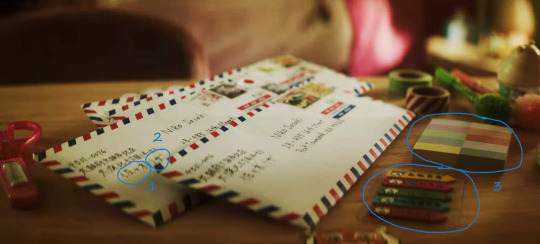
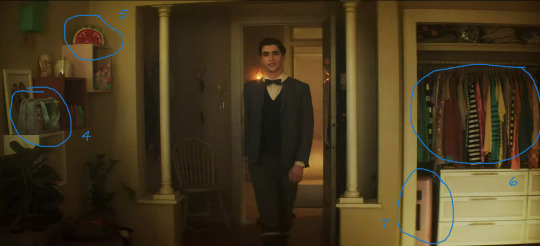
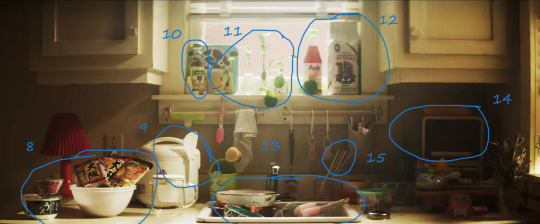
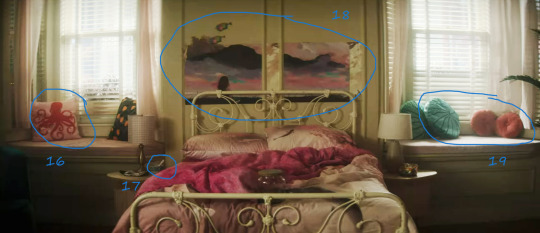

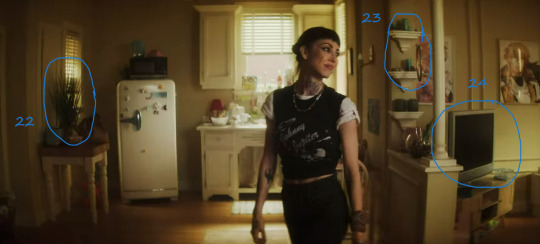

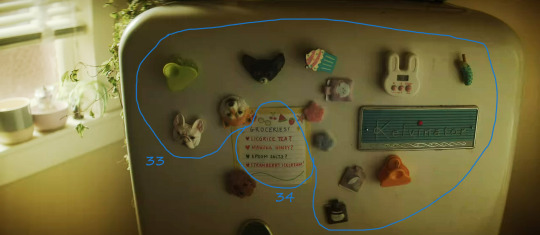
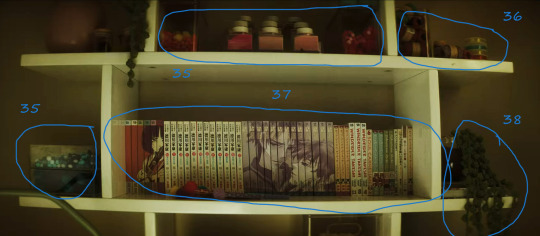
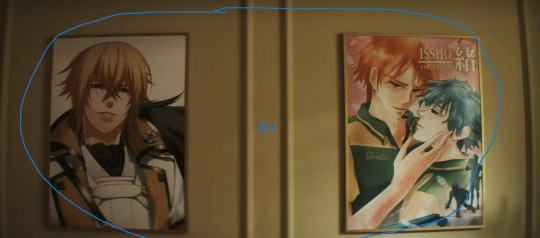
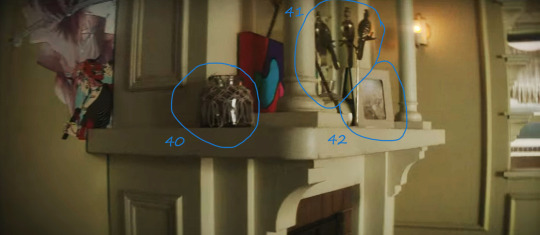
Set breakdown time! Next up: Niko's room.
As before, I've circled the points of interest and numbered them to make them easier to talk about. Cool? Cool. Let's do this!
1: Niko's mom's name! This part is her and Niko's surname. The kanji are 佐々木.
佐 – sa, meaning help or aid
々 – an iteration mark. When you see this, basically it means "exactly what the last one said, one more time." So another sa meaning help or aid
木 – ki, meaning tree
It's really neat that they picked a last name for her that doubles down on her role in the narrative. Just like Niko is there to support and help other characters in whatever way they seem to need, her surname hammers it home by including 佐 not once but twice.
2: Riza (リザ) Niko's mother's given name. Somewhat odd here is that it's written in katakana and not kanji. Without getting sidetracked too much (you can pop over here to read more if you're interested) most Japanese people write their names in kanji.
Katakana seems like a bit of a strange choice here, unless a) Niko for some reason doesn't know the kanji for her own mother's name (weird, given that she's in high school) b) her mother is a foreigner (a possibility; foreigners usually write their names in katakana) c) the set designer/whoever prepped the letters didn't know the appropriate kanji for "Riza" (seems unlikely, given how accurate all the rest of this is) or d) some sort of personal habit. An interesting side note is that her letter to Niko also puts Niko's name in katakana.
3: Cutesy stationery, used for marking your place in a document or book
4: A cute blue purse!
5: Watermelon! Judging by the shiny material and placement near the other bag, I'm going to guess this is another purse
6: Niko's clothes :>
7: Pink luggage
8: Lots of instant noodles
9: A rice cooker
10: Rice vinegar
11: This girl LOVES her some plants
12: Probably food items…? The one on the right looks like it might be a five-pound bag of rice, but I don't recognize the brand
13: Lots of unwashed dishes
14: A toaster oven
15: Chopsticks
16: A cute octopus pillow. I think I saw someone mention that it's from Ikea :>
17: She often leaves dirty dishes sitting on the bedside table
18: A painting of what seems to be a skyscape
19: Brightly colored pillows
20: Metal art in the shape of a moon
21: A decorative window hanging
22: More plants :)
23: Candles
24: Her tv
25: Cute pens with pompoms on the end
26: Regular tape
27: A cute cat statue
28: Marble Pop Ramune, strawberry flavor. Ramune is a type of soda that's a popular festival drink in Japan. It's sealed with a glass marble and you have to pop the marble down into the little catch basin before you can drink it.
29: Anime wall décor
30: Fruit jelly cups. In Japan, small gelatin based snacks like this are popular. They're tiny, about an inch tall, and you eat them in just one or two bites.
31: Niko's laptop. She has stickers on it
32: Washi tape! It's decorative Japanese tape, often with bright colors and patterns, used for crafting.
33: A lot of cute magnets, including the bunny one, which serves double-duty as a kitchen timer
34: Niko's grocery list. The only thing on here that's here because she wants it is strawberry ice cream. The rest of the items, licorice tea, manuka honey, and Epsom salts, are all natural remedies. She's been trouble-shooting how to get rid of the effects of the sprites. She knows she's sick, but not why
35: Cutesy craft supplies! Sequins, glitter, and pompoms
36: More washi tape!
37: Niko's manga collection. She is that particular brand of organizational mess that does not put her numbered volumes in order. She has made an exception for the series that makes a complete picture when you line them up, though
38: More plants :)
39: Manga posters! Issho is one of the series that she has on her shelf
40: A decorative jar
41: Little metal bird sculptures
42: What seems to be the only framed picture in her room. The angle is wrong to see what the photo is, but it's interesting that they added just one in here. Maybe it's her family…?
163 notes
·
View notes
Text
welcome to philo | jeremiah


summary: Jeremiah knows your flower order by heart, and you plan on repaying the favor in kind.
tags: nsfw (mdni), developing relationship, gn!reader (no specific descriptors), banter, flowers, exhibitionism, oral sex/blowjobs, feelings, jeremiah losing his mind, swearing, m!orgasm, facials, (1) xavier mention
wc: 3.0k | ao3 | kinktober in deepspace masterlist
a/n: first time giving jeremiah some lovin' and i have no idea how it spiraled into this but we are here :D

Soft notes of plucked guitar strings and accompanying percussion filter the floral air of Philo, marking another quiet yet fulfilling day at play.
Jeremiah enjoys these moments of peace, lost in thought with his hands neatly arranging a new vase of freshly bloomed marigolds.
It still took some time getting used to, truthfully. A life where turbulence and struggles amongst the cosmos that once felt like yesterday began to dwindle in the lanes of his memory. The warmth of Linkon City was a form of domesticity he had the privilege of knowing. Though, it didn’t hold the same shine to the bask of Philos’ cobbles and fields.
Even so, he’s made great efforts to carry on since. Jeremiah believes he’s done well for himself, and his cherished flower shop is a testament to it.
He dusts away the nostalgia amongst the skirt of his apron, gloved hands rough at the friction when his masterpiece is finally set. The golden petals stood proud, a reflection of their crafter’s touch.
A chimed ring accompanies the completion in apt timing, soft footsteps echoing soon thereafter.
The florist straightens his back, puts on his practiced award-winning smile with a chirped, “Welcome to Philo.” He’s ready to roll out his customer-friendly and marketing genius spiel when he pauses in his tracks, eyes widening in recognition. “It’s you!”
“It’s me,” you wave back in greeting. Your strides make their way to his countertop, where he excitedly pulls you in for a half-hug. “Business hours slowing down?”
“A bit,” Jeremiah says, pulling back and a smile in his eyes. “Are you here for your usual?”
You nod, settling your hands along the edge of the cool marble. Jeremiah is quick on his feet, scurrying around the tiles and swiping at certain pots. A handful of fine greenery, baby breaths for a splash of white decor, and the main star—pale blue florets with a ringlet of yellow blossomed in the center, each of the three pieces beautifully nurtured and bright. Bunches nestled in his arms like a newborn, he slides past with a playful wink and lays them before you.
“You’re the only one I know who still orders these kinds of flowers,” he comments, reaching for a pair of scissors. Procured from his hip pocket, he carefully snips at the excess leaves, green plates of flora fluttering to the floor.
“And you’re the only one who knows how to care for them properly.” You prop your chin into your palm, observing him in interest. The florist was in a world of his own. It was truly admirable to see someone so dedicated to a craft as intimate as floral arrangements.
“The best in Linkon, no one does it like you.”
Jeremiah chuckles, laying out a pattern of baby breaths and myrtle atop a clean sheet of parchment. “I’m flattered. Don’t let the other flower shops hear, surely they’ll come and be nothing but a pain in my ass.”
You laugh with him at the thought, shaking your head. “Nothing wrong with keeping your competition on their toes.”
Taking one of the three blue focal pieces in hand, you carefully push at its petals, silken soft to the touch. It was fascinating, a small piece of life so fragile yet present in your grasp.
By the time Jeremiah notices his last piece was missing—presently doted for in-between your fingers—the bouquet was only a centerpiece and hard string away from being complete. He clears his throat, noticing you jump in surprise, before a sheepish smile dressed itself across your expressions alike.
“Ah, right. Sorry,” you hold out the flower to him, a bridge from your heart to his. “Didn’t mean to interrupt the master at work.”
With a faked tone of lower cadence, Jeremiah offers a generous, “But of course, you are forgiven.” His best attempt of mimicking a kind and benevolent ruler, though it cracks towards the end into his regular voice.
You half-curtsy once the flora was out of your hands, raising an imaginative skirt in the air. “Oh, how gracious of you, good sir.”
He lets out a softer chuckle, before quickly wrapping the composition into a perfect bundle. A loop of string later, he lifts the flowers tenderly, one hand at the base and the other underneath the bedding of petals.
“For you, my liege,” Jeremiah jokes, though it strums his heartstrings when you let out the sweetest laugh. He could feel a flush tickle his neck, to which he holds in an odd form of defense with a clammy hand. The other is still outstretched, waiting for you to accept his graces.
To which you happily take in, eyes wide in appreciation and the flora reflecting in its glimmers. “Thanks, Jer,” you speak into the petals, inhaling them calmly and enjoying their fresh scent. “I owe you one.”
“No, no,” Jeremiah shakes his head, hands in his hips in turn. “I’ve told you before. These are always on the house for you, just as long as you swing by.”
“Mm.” You hum, before gently placing down the bouquet to the countertop. “Still, it doesn’t feel right. To just always take some of your flowers with no real payment in return.”
You were sure that wasn’t a viable business practice either. It’s been this way ever since you were first introduced to one another; you’d say hello, and Jeremiah would send you off at the end of your visit with a smile and selection of budding flora in tow.
“That’s—“ Oh, the words lodge themselves in his throat when he feels something warm touch him. It would’ve scared the wits out of Jeremiah, if it weren’t for the gaze that found itself on your hand—neatly perched atop of his.
Jeremiah stumbles in his response. “That’s, ah, fine?”
Fine? He wasn’t sure when it turned into a question, nor when did the air in his greenery space become so… impeccably stuffy. But Jeremiah just stares at your hand, processing it all before sparing you a glance.
“You don’t sound so sure,” you tease, tapping the pads of your fingers against his knuckles. In a blink, you’ve met him halfway across the counter once more—though this time, your noses were only a hair away and he could see his surprised expression so clearly in your mischievous eyes.
Your voice lowers some, paying attention to the growing flush that stains his cheeks. “Let me pay you, Jeremiah.”
“I—Wow, you’re pretty,” he blurts out.
He meant pretty close, though ‘pretty’ wasn’t exactly wrong either. The sunlight dripping in from his ceiling rooftop painted a halo around the crown of your head, shadows gently shaping your face into a newly bloomed sunflower. More than just pretty, he thinks to himself. An absolute angel, even.
Jeremiah bites his lower lip in quick realization and embarrassment, though it only curls the edges of your smile further. “Thank you,” you say, tilting your head in thought. “So, can I take that as a yes?”
He considers this. “I have a feeling that if I say no, we’ll just be going in circles,” he says, more so to himself than in answer. Thinking out loud, letting the ideas process in the moment they occur.
“Maybe,” you shrug. “Maybe not. I promise I’m flexible, but I just think…”
You manage to turn his hand over, and much to his surprise, he naturally accepts the way your fingers slide into his. Warm, very, very warm. And soft. But more importantly, your hand is entwined with his—and he likes it. Jeremiah likes the feeling of holding your warm, soft hand.
When you squeeze his hand, it pulls him out of his thoughts and back to your words of, “You deserve to be compensated and taken care of, Jer.”
“I do?” He sounds almost bewildered at the fact.
“Of course,” you say, stating the obvious to his oblivion.
Slowly, you bring your closed hands to your lips, looking past your lashes and enjoying the sight of rouge blush saturating his skin. A kiss as soft as those silken petals touches his knuckles before you pull away. Even through the fine leather covering his hands, he feels their presence.
It would be fine, Jeremiah thinks, if he passes away at this moment. If he lets the heavenly graces take him away after receiving a piece of love so tender, from someone he’s grown to adore—it would be fine.
And also, because it has his mind running a hundred miles per hour at the thought of wanting all of that and more. Put him out of his misery to save him the embarrassment of these heated feelings immediately at the forefront of his mind.
“Let me pay you,” you repeat, a quiet intent slowly sinking into your words. “Please?”
Knowing his voice would betray him somehow, Jeremiah only nods and says, “Alright.”
—
Jeremiah is a mess.
He normally prides himself on being organized, keeping things in shape and surfaces clean. After every bouquet, he would sweep the floors and recycle leftovers—even spray down the marble with disinfectant and wipe until it was sparkling clean. Like clockwork, he’d dust his skilled hands across the skirt of his apron and feel that it was another successful day. Whistling while he works, keeping up a tune to the radio or one from his imagination—Jeremiah’s day normally went like this.
Today had almost everything on that agenda. What would he call his, though? A special occasion, probably?
Those very same hands, now gloveless, found themselves tangling and toying through your hair. The lips that push together in an airy shrill of whistles are currently? Pushing out quieted moans of your name, head lolling back from the ecstasy of it.
Jeremiah shouldn’t be doing this.
Uniform in disarray as much as his curls of auburn, his back practically engraving the countertop’s edge into his skin from how hard he was pushing against it. The zipper of his pants long forgotten, the fabric pooling around his ankles.
Oh, but Jeremiah realizes that there’s something so ungodly pleasant about seeing your lips hover above his cock. Tongue flat against his length that currently hides between a fine layer of cotton boxers. The fabric ran a shade darker from where the heat of your touch traces it, leaving quite an impression.
Jeremiah is a mess, at your disposal, and can’t deny that a part of him screams in joy.
“You,” he breathes out, somehow finding his voice amidst the lustful sighing. “I told you, we—we could’ve done this in the backroom.”
“And I said I wanted you here, Jer.” You press a meaningful kiss to his lower head, smiling when it twitches at your touch. A firmer press allows the stained spot to push past beads of pre to your mouth, and you hum at the tanginess through soiled cotton. “Besides, no one’s going to see us, yeah?”
“I-I mean, yes.” Jeremiah confirms as much, making an effort to conceal the shop with a wave of energy.
To the naked eye, the glass interior of his shop houses his well-grown plants and marble befitting of its owner. To Jeremiah’s wide gaze, he could only watch the way you make your way downwards, kissing and caressing wherever possible.
“But it’s not going to last, and ah—hah, shit—“ He hisses when your hand squeezes along his length, and he could feel your nails lightly drag along the underside. “I can’t concentrate when you’re down there like this.”
It’s not the first time he’s managed to conceal his shop from the outsider looking in. Sometimes it was required, especially when Xavier tumbled in and out as he pleased, evol abilities damned and secrets afloat. It was, however, the first time he’s had to pull strings just so no one would see the show playing out at the reception countertop.
A shiver ran down his spine whenever his eyes made contact with a passerby—fleeting, and wondering if they could somehow see past the veil. See how there was an angel between his legs, and that he enjoyed it.
You let out an almost pitiful hum, though the sympathy differs from the fingers dipping past his waistband. “Mm? I think you can, don’t underestimate yourself.”
The thought was kind, but even Jeremiah had his limits. His hips cant on instinct when your unblocked warmth curls around his length, only growing with need by the second. Swiftly, and much to his relief, you free him from those confines.
“Wow, Jer. You’re real pretty,” you coo, delicately raising your fingers from the cusp of his base to the curved head of his cock. “Hard just from looking outside?”
“Wha—No, I just,” he stutters, but even he can’t deny it. One glance to beyond the glass and back to your knowing smirk has him weak in the heart but strong where it matters. “Just keeping a lookout,” he strains.
Flush and stiff from the newly exposed air, you take your time in stroking him. An occasional press to the skin just below his tip has his knees buckling. He fit perfectly into the palm of your hand, a beautiful sight and weight to behold.
“Maybe let down the curtain then? I’m sure everyone would love to see their precious florist be deflowered like this,” you tease lightly.
‘Someone might see’ rings like blaring sirens in his mind—and for a moment, he seriously considers it. Jeremiah’s blush only worsens, the thought doing a number to his senses. He dares to raise a witty quip in return, but it melts into a gasp when your lips seal themselves over his leaking slit.
You have the gall, he thinks, to hum around his cock this way. And look devastatingly stunning too, eyes round in pleasure, all for him to see. To feel, to watch how you take care of him.
His fingers cradling your head tighten some, though nothing too heavy-handed. Whether it is your doing or his, you make a slow descent down his length, jaw slacking to take in as much of him as you could.
If he thought your hands were warm, your mouth was an oven that neatly shaped and swallowed around him. He feels you huff, before firmly rubbing your nose to his abdomen and a garbled noise rouses from you.
“Don’t force yourself,” Jeremiah pants, gently leading you away from his nestled cock.
You allow him to do as much, popping his head from your lips and smiling. The lightest string of saliva pulls at your bottom lip and stays with him—Jeremiah can only stare, entranced.
“On the contrary,” you say, a slight grit to your voice from the loss. “I’m doing all of this because I want to.”
Room for argument falls naught when you return to his erection, and that devilish warmth warps his senses once more. With every bob of your head, Jeremiah’s wanton moans only grow in volume. You search for his hand—which, currently gripped the counter for dear life—and bring it to rest around your throat in permission.
His fingers twitch over the skin, before realizing he could feel it. No way, no way. Curiously, Jeremiah presses his fingers closer to find that his cock occasionally brushed them, the shape all familiar and busied down your throat. It tingles, feels way too good, especially when you hum in delight.
“Oh, I’m about to—yeah, yeah,” Jeremiah rambles, abdomen clenching at the rush of searing heat spreading throughout. “Gonna cum, come, shit—!”
In the heat of the moment, his hand draws you away from his cock, throbbing and welcoming warm streams of his undoing. You work him through the spurts of release, leaning down with an open mouth to capture what you could. Some of it lands on your tongue, hanging off of the curves—a majority stuck to your cheeks and painted them in a viscous white, smooth and sticky all the same.
Jeremiah feels like a leafless stem, waning in the wind and completely blissed out by the time he comes to. His fingers massage your skull gently, and his half-lidded gaze blows wide when he realizes what an absolute mess he’s truly made this time.
“Oh, sorry, let me get that.“ He searches for his apron, only a few inches away and neatly crumpled in a pile. The pockets, somewhere in there is—ah, he pulls out a small handkerchief, pleating the square and bringing it to your cheek.
You follow his hand whenever it swipes at his excess cum, patiently waiting and watching with satisfaction rimming your eyes. Jeremiah is gentle, patting and swiping alike with the calm moment settling between you.
“There,” he declares, putting aside the fabric that definitely needed to be washed. A wave of decorum crashed against him, and he’s quickly pulling his pants into place. Bringing you up with him, he smooths out your hair and starts to ramble. “Are you okay? Was this alright? I know we kinda just, went for it and all, but I—“
You squish his lips together with a press of your finger, amusement clear in your sigh. “Yes, yes and yes.” You pull your finger then, tapping your own lip in thought. “If anything, those should be my questions to you, Jer.”
Jeremiah blinks, then listens to the pace of his heart and rise of his breaths. To which he deeply inhales and says, “Yeah, I’m great. Thanks, actually.”
The blush settles into his ears this time, and you can’t help but reach for them in a light pinch. “Cute,” you mumble, though loud enough for him to hear—the red only deepens because of it.
“A-anyway, your flowers,” Jeremiah coughs, waving a hand sheepishly towards them. “They’ve been, well, paid for.”
You turn, picking up the lovely arrangement and hugging it to your chest in content. “I’m glad,” you nod, before pressing a fleeting kiss to his unsuspecting cheek. “All is well!”
Before he could even scramble to words, you were already halfway across the tiled floor and standing at the entrance. Flowers nestled in your arms, and a smile so brilliant it made them seem dull in comparison. “Same time next week?”
Jeremiah cups the cheek where you touch lingers. In his heart, the budding adoration grows another branch, his affections blooming steadfast.
“Yeah.” He finds himself smiling back. “I’ll see you then.”
#kinktober#love and deepspace#jeremiah#love and deepspace smut#lads smut#lnds smut#lnd smut#jeremiah smut#jeremiah x reader#lads x reader#lnds x reader#lnd x reader#love and deepspace x reader#love and deepspace scenarios#love and deepspace fic#jeremiah x you#love and deepspace jeremiah#lads jeremiah#lnds jeremiah#lnd jeremiah#gklnd#grandisknight fics#grandisknight kinktober
112 notes
·
View notes
Text
They call you the Stitch Witch. Because you form little bits of magic in every thread you use. Every loop, weave, and piercing of the needle sparks a bit more into what you're fixing.
It begins with a ghost. Only remembering the shroud marking them as dead, they come to you as a simple sheet. After some thought, you get hair donated and use it as your thread, embroidering patterns and attempting to pull memories from the ether. They become humanoid, but remember there are more, wandering and lost.
Always the same, sheets marking them as dead. They beg for your magic and memory retrieval. You explain to your village, and soon many are donating their hair to help in your endeavor.
Some only need a few stictches and are on their way into the afterlife. Some are nearly a new tapestry when you're done, and you've guided them through unfinished business.
The Guide brings more to you, but never asks for more so they can pass on. You entertain them as a good host should, offering them a polite cup of tea and offerings generally reserved for the dead. They seem happy and appreciate all you do, giving small things like messages and news from other parts of the world.
Sometimes families of the deceSed come by and offer their gratitude for helping identify their loved ones and putting them at rest. It's not much, but it's honest work.
Years pass, and you have a small gap in clientele for the first time in seasons. Your hair has started to go white, and calluses have long formed on your fingertips.
Others have picked up your craft, spreading awareness and assisting many around the region. Of course, you're still the one many go to. And your first client always brings in new customers.
But today was different. There was a stillness in the air, the air finally taking on autumn's chill, but a few shuddering breaths of summer remained.
The silence curled through the air like the steam rising from the tea cups. The Guide sat and stared at your latest project, a combined tapestry of nearly a dozen types of hair, forming a rich forest scene.
"Are you ready to move on?" The words were out before you realized.
They shook their head, hovering a few finger widths above you.
"I have unfinished business."
"Let's stitch some memories." You pull out a spoon of dark hair, curly and thick, and cup you hand under the edge of the shroud, pulling it toward you. While the edges are frayed, some having faded into the ether , you see a few white ones that seem fresh.
"And try to make sense of it all. Finally make a map of your unfinished business "
"I'm afraid I can't." Translucent hands form and take yours. Your skin tingles, like it's fallen asleep.
"why not?"
"Because I know what it is." Hands squeeze yours once, twice. Three times.
"There is one soul I want to make sure I guide to the other side. But they aren't wrapped in a shroud. Until then, I will remain. Creating memories and mapping out this life."
And freezing lips press toward yours, the cloth barrier making it rough, like the faintest hint of scruff on a chin. Lips form, but are like chiseled marble, too hard and unmoving. When they pulled away, threads moved across their shroud, twisting into braids and knots that just as quickly untied themselves.
"Who I was before doesn't matter." They assure you. "I feel like these threads pulled us together for a reason, and it would be a shame to damage this work of art by cutting them."
Your lips still tingled at the memory of their touch. Reaching up, you pluck a few hairs from your scalp, slipping them into a small pouch.
"Then I expect you to be there and ready to guide me when my time comes. And I'll finally get to see your true face."
You reached out and touched the shroud. Pins and needles went up your arms. Not unpleasant, but certainly... Different.
The places your hands traveled formed under your fingers, memories of a body allowing it to form.
You kissed Guide again, a chill going through your being. Closing your eyes, you blew into where their mouth would be. And for an instant, the limbs formed and arms wrapped around you.
"I've wanted to do this for years." They whispered in your ear. "To feel your warmth in this icy world."
"Do it as long as you like." You leaned into them, a smile on your face.
You had been one another's constant, and knowing it would continue into the next journey gave you a bit of comfort, and you could already see the memories forming, creating a small picture in your hearts.
#monster lover#monster love#monster boyfriend#monster romance#monster x human#monster fucker#monsterfucker#terato#monster girlfriend#Idk what I was doing with this#Just had the thought#And was dwelling
118 notes
·
View notes
Text
nemesis cabin headcanons



children of nemesis
• they’re the ONLY cabin that is safe from pranks by the hermes cabin.
• they never have problems with balancing chemistry equations.
• whenever someone from camp needs to settle a debate/argument, they always ask someone from the nemesis cabin to be the mediator/judge.
• they're also frequently asked to be referees for games of capture the flag, as their reputation for fair judgment makes them ideal for ensuring the game is played with integrity and without bias.
• when a child of vengeance is saved of a certain death by another demigod, they now owe a debt to their savior.
• whenever the savior calls for help, they are obligated to come and help them no matter the danger.
• they are all CRAZY competitive. it’s like they're in pre-revenge mode.
• the demigod that nemesis traded the ability to make a difference in the world for one of their eyes was nick fury (and ethan).
• at this point, she just has a passion for children with eyepatches.
• i can just picture nemesis cackling and pointing to her children "you get an eyepatch" "you get an eyepatch!" "but mom-" "EYEPATCH FOR YOUUUUUUUUU!!"
• they care the least about the appearance of other people, because they see their mother as the person they hate most.
• the hephaestus cabin helped them build a gigantic celestial bronze scale in the middle of their cabin.
• they don't get along well with the children of athena, largely because many of them struggle with hubris as their fatal flaw.
• since nemesis is the goddess who punishes those who are overly prideful or self-assured, this same principle extends to her children, creating natural tension between the two groups.



cabin exterior
• the cabin has dark stone walls, almost like slate or obsidian, giving it a brooding, intimidating appearance. the stones have subtle cracks running through them, symbolizing the balance of vengeance and justice.
• deep red and crimson accents are used around the cabin to signify blood, vengeance, and the balance of power. the entrance to their cabin is a red door. it has the scales of justice etched into it, representing nemesis’ role.
• above the doorway, there is a carving of an eagle, nemesis' sacred animal, holding a sword in its talons. the sword represents retribution, and the eagle embodies her watchful, unforgiving nature.
• a small statue of nemesis herself stands in front of the cabin, holding her sword and scales, symbolizing the ever-present concept of justice. her eyes are made from rubies, watching those who come and go.
• the shadows cast by the cabin seem to move subtly, giving the impression that the cabin itself is watching or judging those nearby. these shadows stretch and shift depending on the actions of the people passing by.



cabin interior
• the central theme of the cabin is balance. there are symbolic representations of scales EVERYWHERE— on the walls, carved into the furniture, painted in murals. every item in the cabin is placed with perfect symmetry, reinforcing the idea of equilibrium and fairness.
• instead of modern lights, the cabin is illuminated by dark iron lanterns or torches with low, flickering flames, casting dramatic shadows around the room. this lighting adds to the cabin’s mysterious and foreboding atmosphere.
• the furniture is made of dark wood— oak and mahogany— each piece sturdy and simple, but elegantly crafted. the chairs and beds have an almost throne-like quality, with high backs and intricate carvings, to emphasize power and authority.
• large mirrors are placed strategically around the cabin, but these mirrors do not show your true reflection. instead, they show you as balanced with your opposite. for example, someone who is overly confident might see themselves looking unsure or humble. these mirrors serve as a reminder that nemesis governs balance in all things.
• the floor is made of glossy black marble, cold and smooth underfoot. some areas are etched with swirling, abstract patterns that represent fate and karma, with a glowing red hue filling in the designs at night.

cabin traditions
• they have a tradition of making penance offerings or performing acts of restitution for any personal wrongs they’ve committed, reflecting their dedication to correcting imbalances.
• every month, the members hold a ceremony where they balance scales to symbolize their commitment to justice and fairness. this involves a ritual where they offer symbolic items representing their past grievances and mistakes.
• they frequently engage in debates about justice and morality, using these discussions to hone their skills in resolving conflicts and understanding different perspectives on retribution.
• each member keeps a small stone where they inscribe significant personal experiences related to justice and retribution, creating a collective memory of the cabin’s journey and values.
divider by @strangergraphics-archive
#percy jackson and the olympians#heroes of olympus#pjo#hoo#pjo hoo toa#pjo series#hoo series#pjo fandom#hoo fandom#pjo tv show#pjo disney+#pjo cabins#nemesis#invidia#nemesis cabin#cabin sixteen#cabin 16#children of nemesis
101 notes
·
View notes